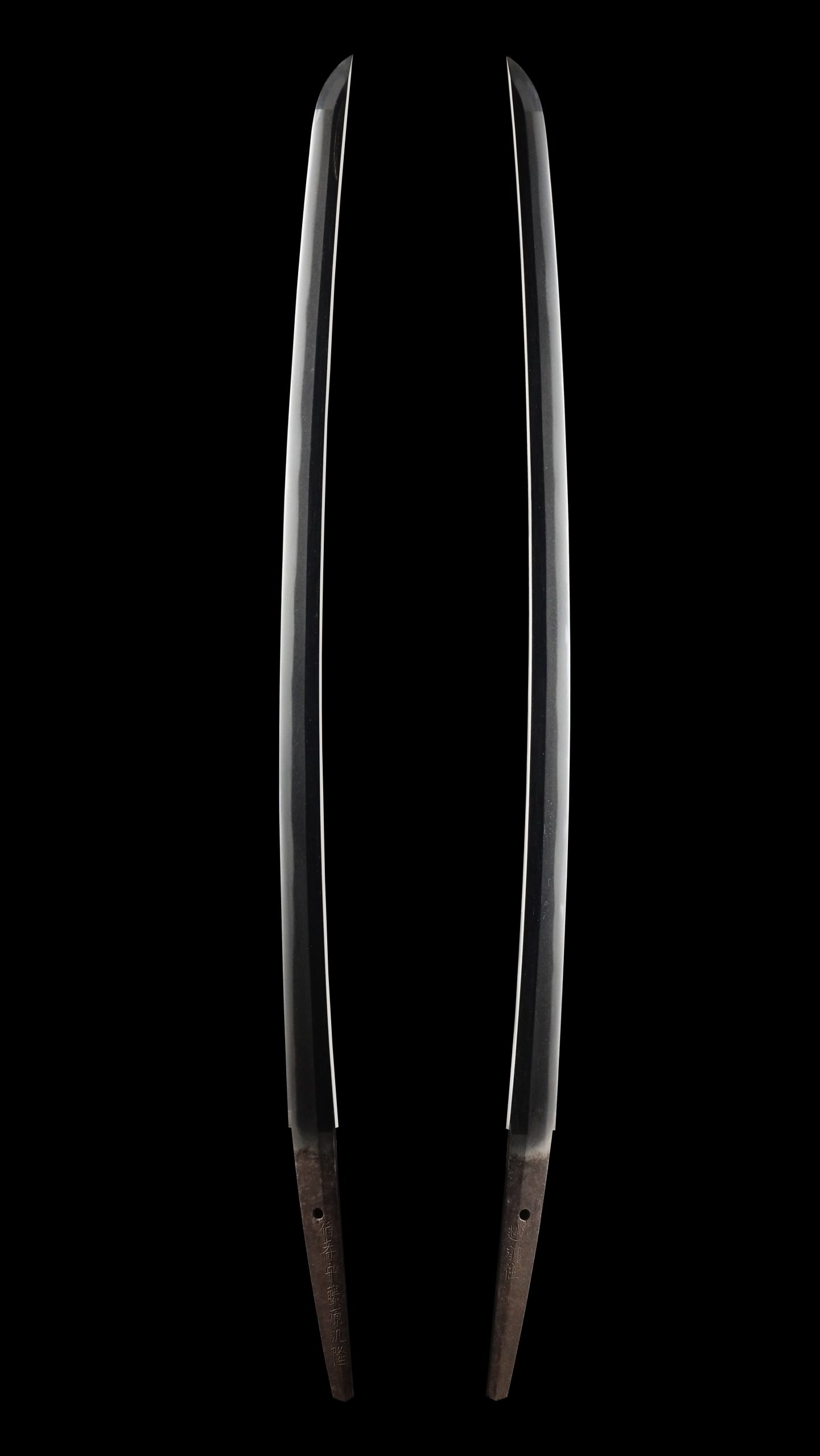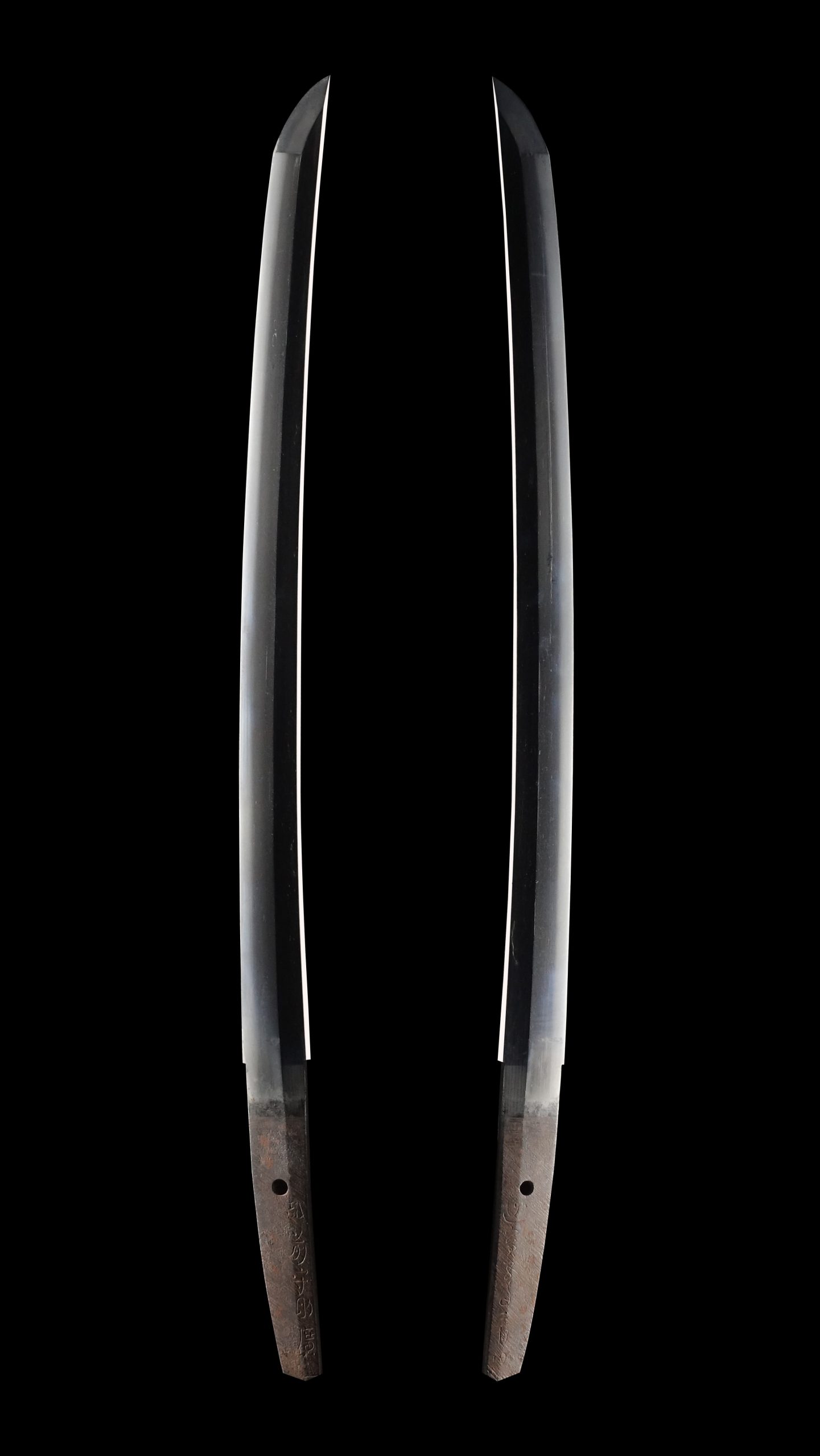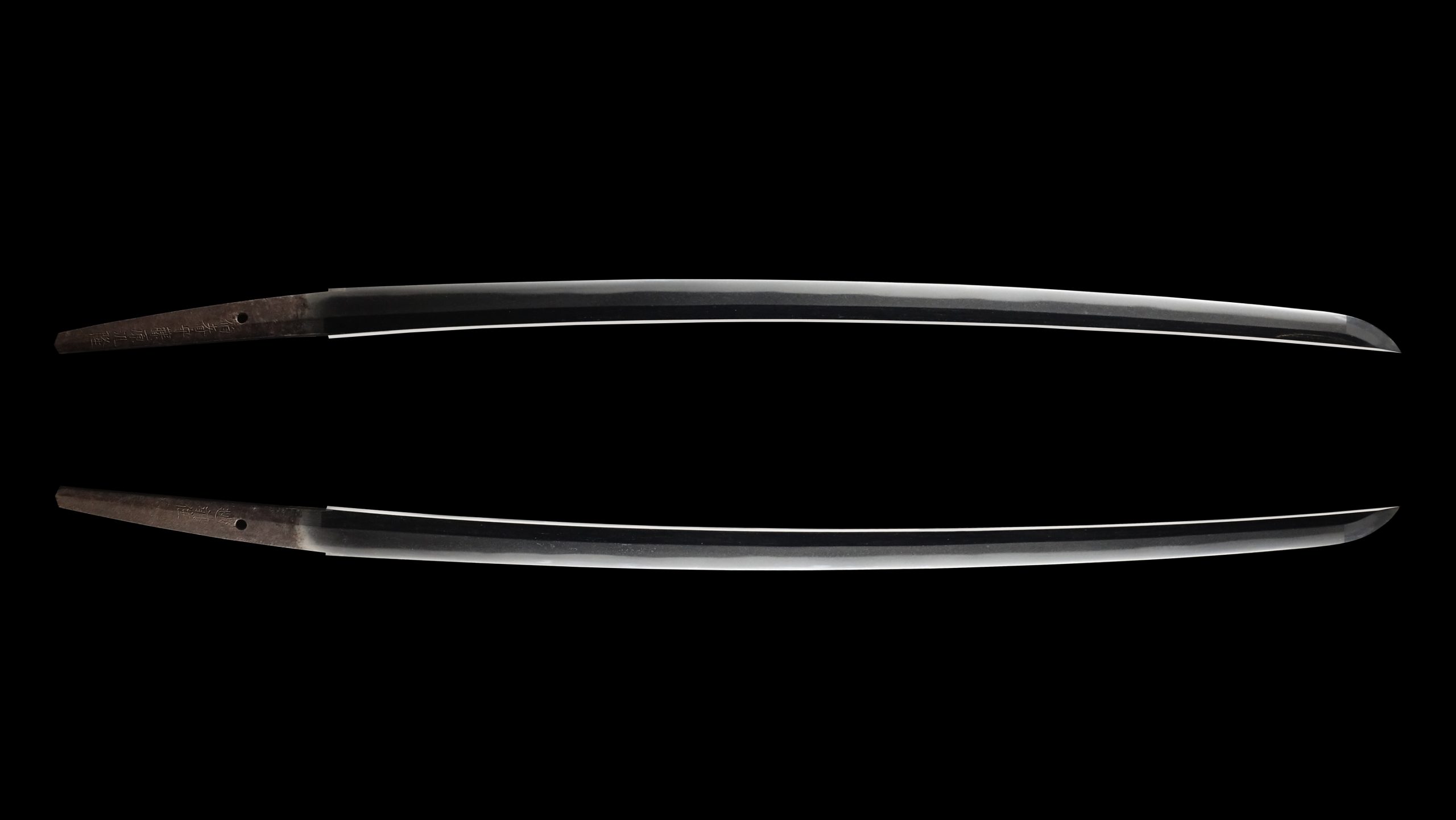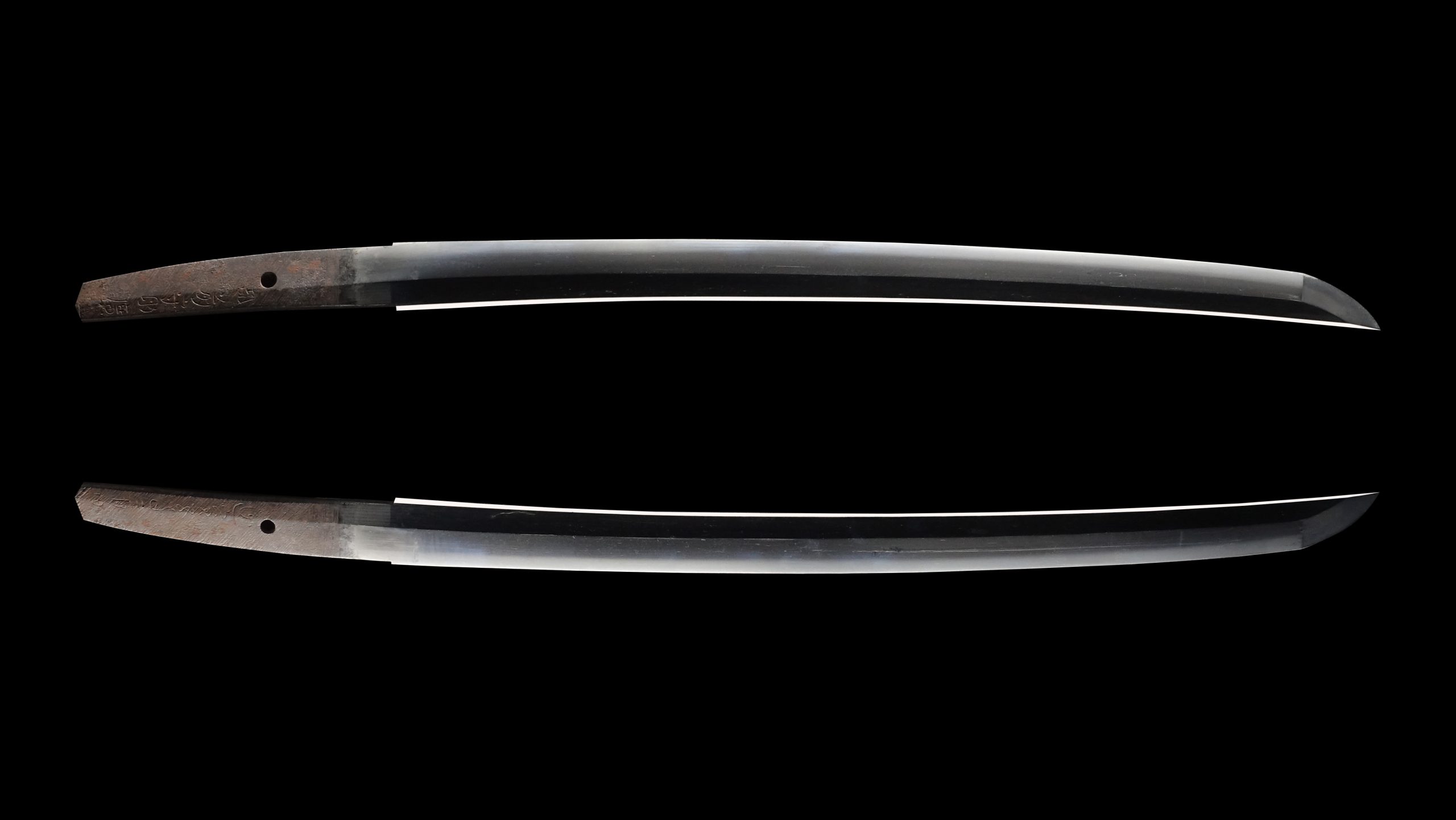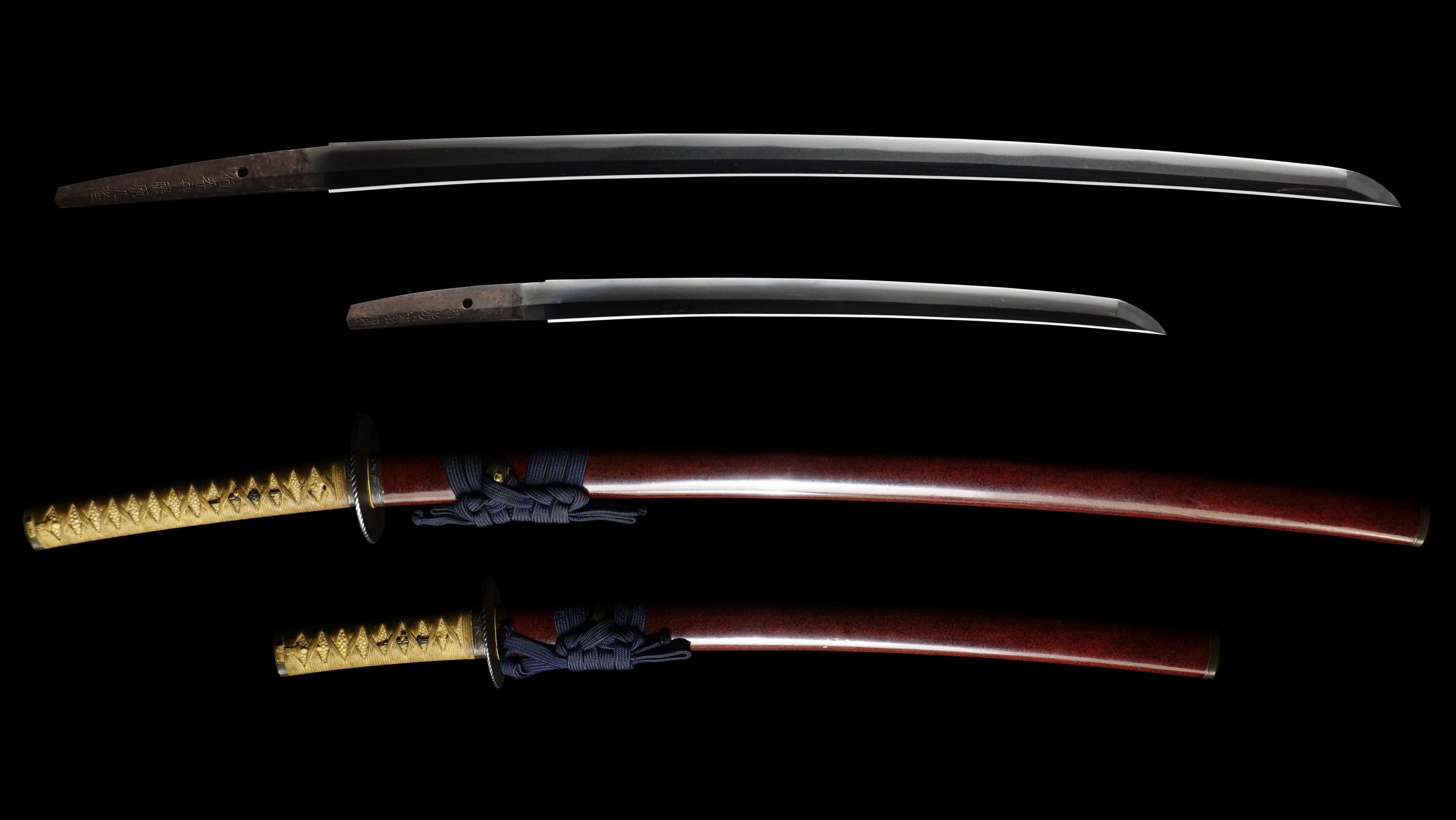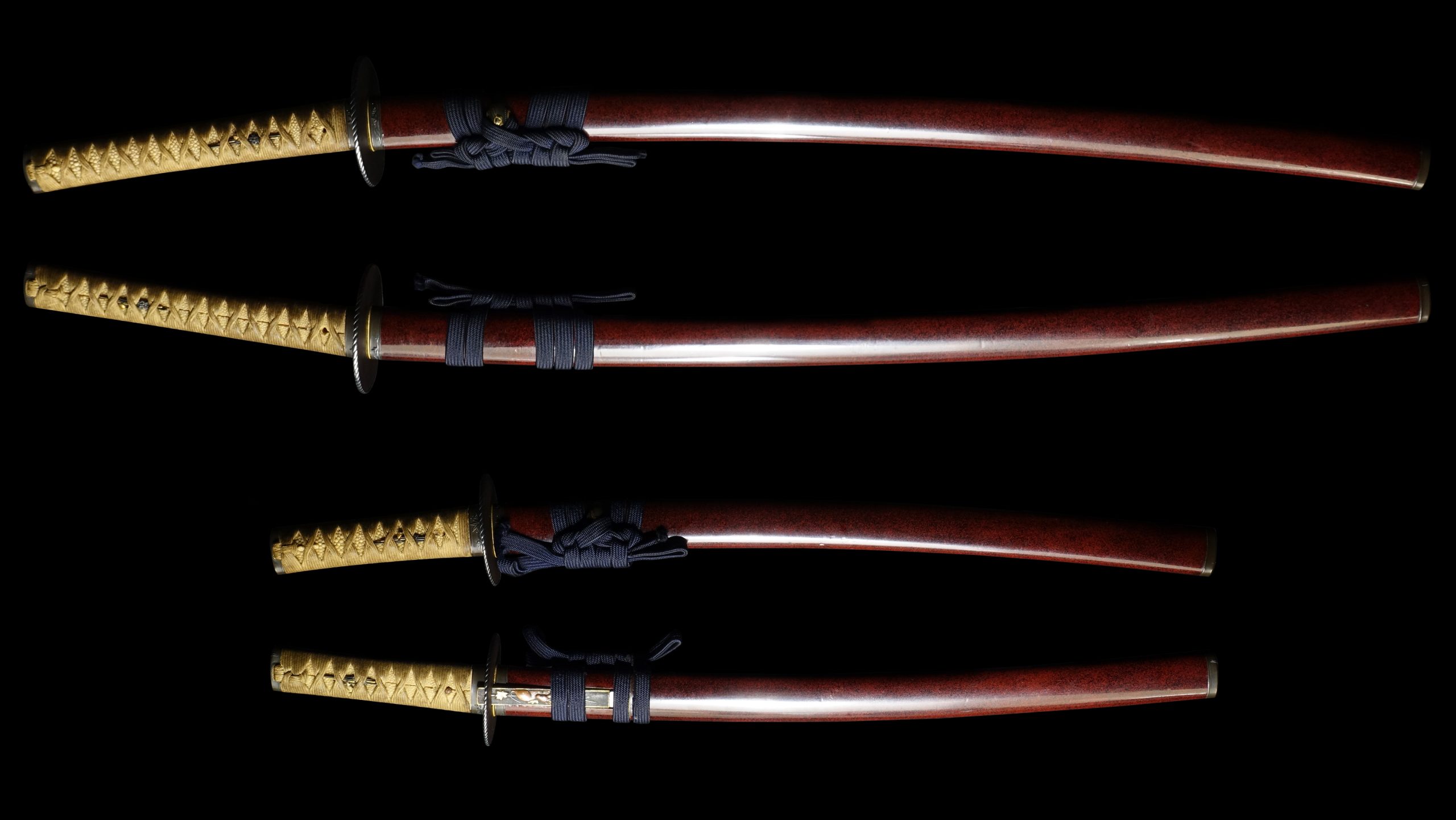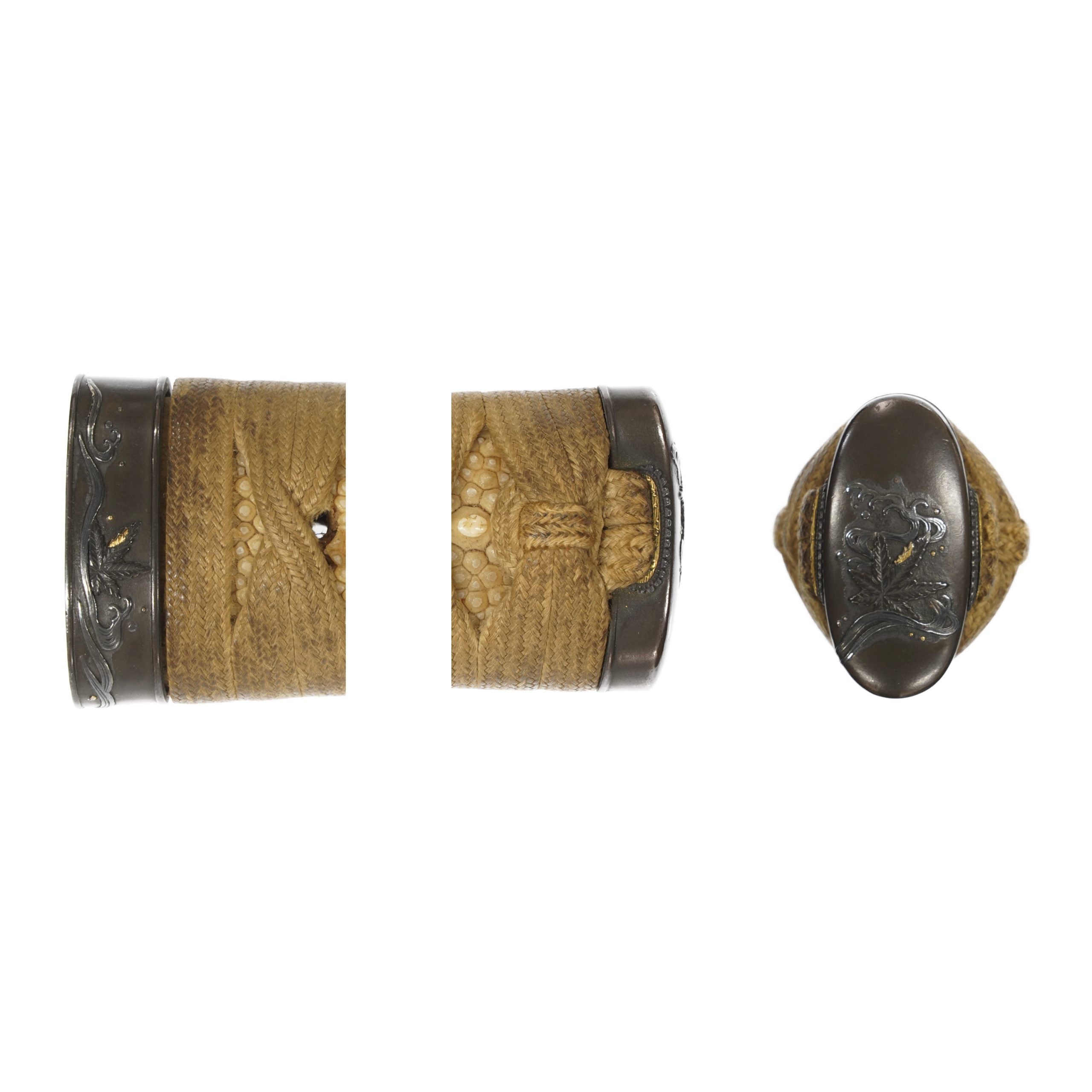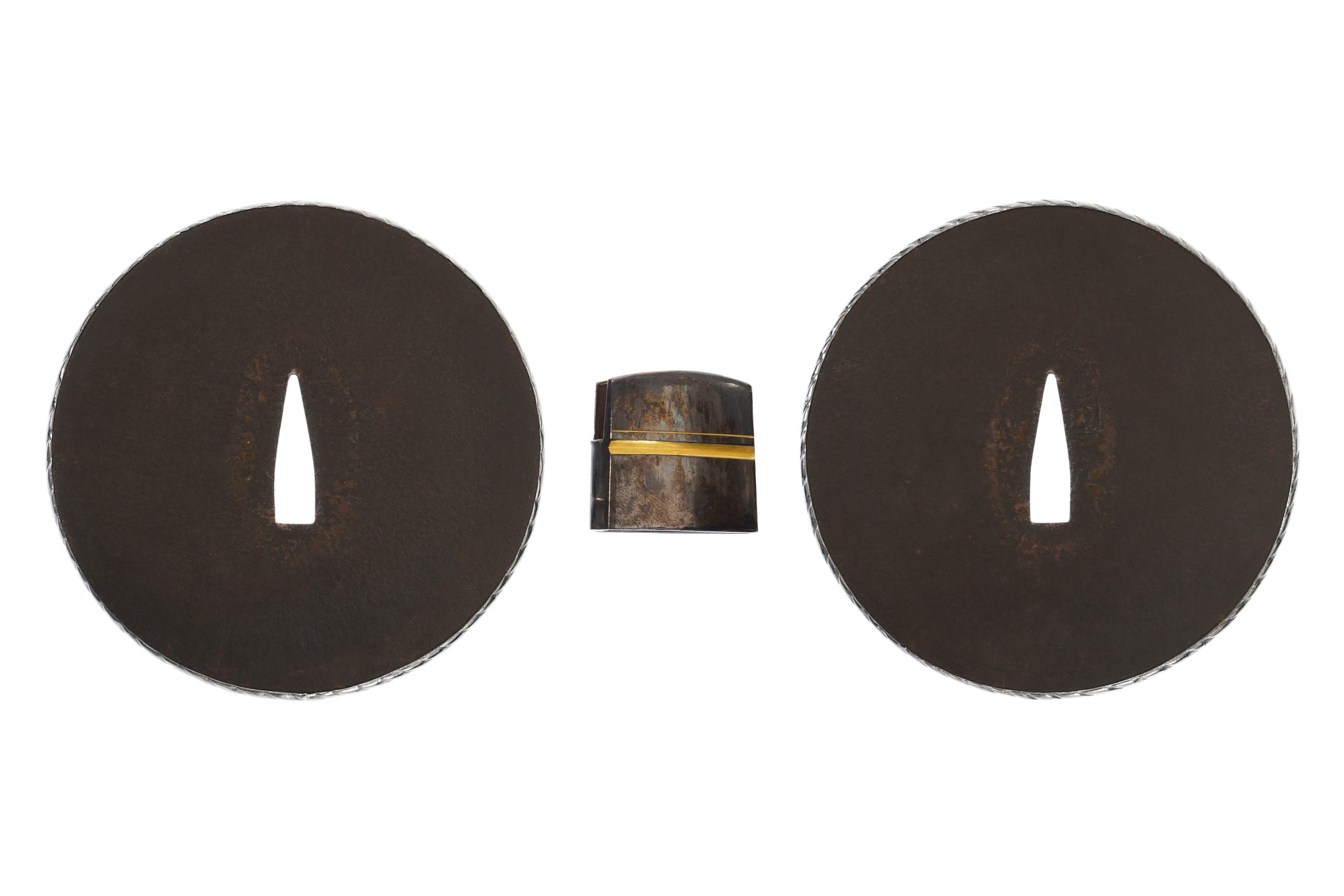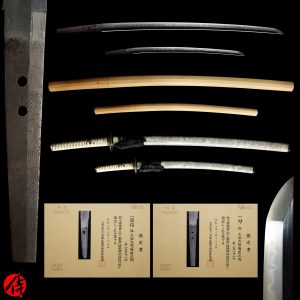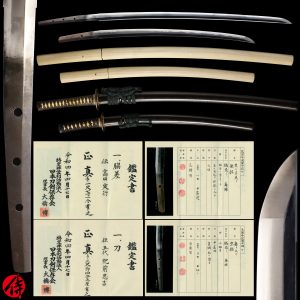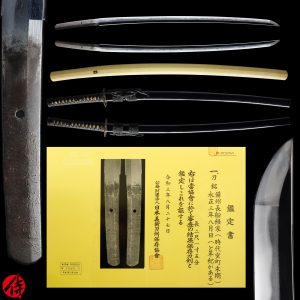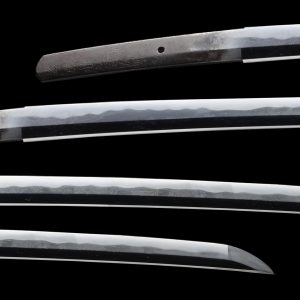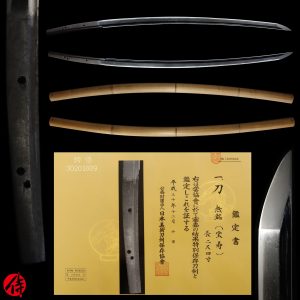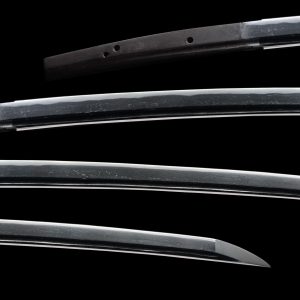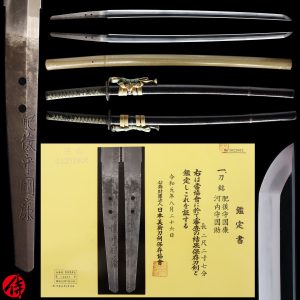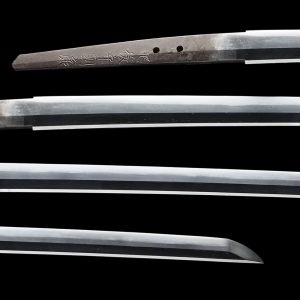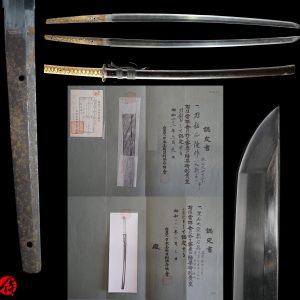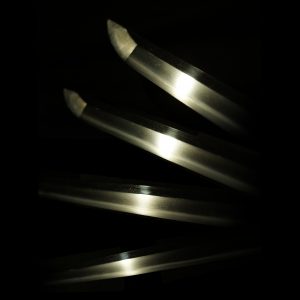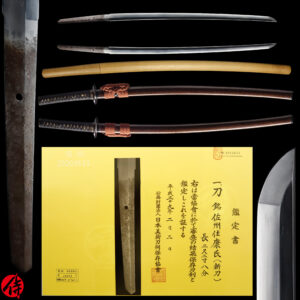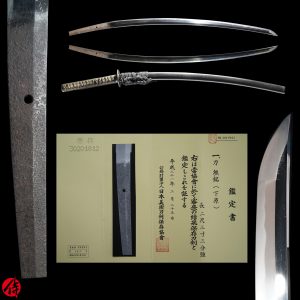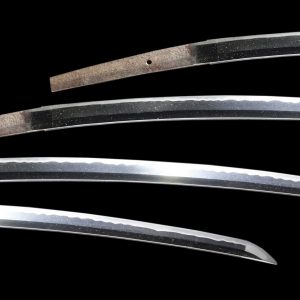Antique Japanese Sword Daisho Signed by Hirotaka&Sukehiro with NBTHK Certificate(Katana) and NTHK Kanteisho(Daisho Koshirae)
【Description】
Katana
This Katana blade was signed by Hoki no Kami Fujiwara Hirotaka( 伯耆守藤原汎隆 ) during the early Edo period(mid late 17th century). Hirotaka is known as one of the prominent figures among those who belonged to Echizen Shimosaka school. He was an apprentice of Kanetane( 兼植 ), one of the most famous swordsmiths in Echizen province.
He received the honorable title of Hoki no Kami(伯耆守 ), which was only given to prestigious swordsmiths. Hirotaka is also known for forging very sharp swords, which made him and his work classified as Wazamono Toko( 業物刀工).
Echizen Province was prosperous during the Edo period, being ruled by the Echizen Matsudaira clan, a direct retainer of the Tokugawa clan who ruled the Edo government. Many skilled swordsmiths moved to Echizen from different regions because of high demand among Samurai who lived there. Among them, a lot of renowned swordsmiths were originally from the Mino province(Gifu prefecture), such as Hirotaka’s master, Kanetane. They are called Echizen Seki swordsmiths.
The MINO swordsmiths style, also known as MINODEN, basically has the TOGARI(Pointed shapes protruding from the Hamon )in a classic straight tempering line and random wavy pattern. MINO DEN had its origin from YAMATO DEN in the late KAMAKURA period(1280 1330). It flourished in the MUROMACHI period(1333 1573)and continued until the EDO period(1603 1868). These Daisho blades have some characteristics of the Mino DEN style.
*Wazamono is a classification of Japanese swords and swordsmiths used in Japan to identify historic blades of exceptional quality in the book written by Kaiho Kenjaku ( 懐宝剣尺 ) in 1797.
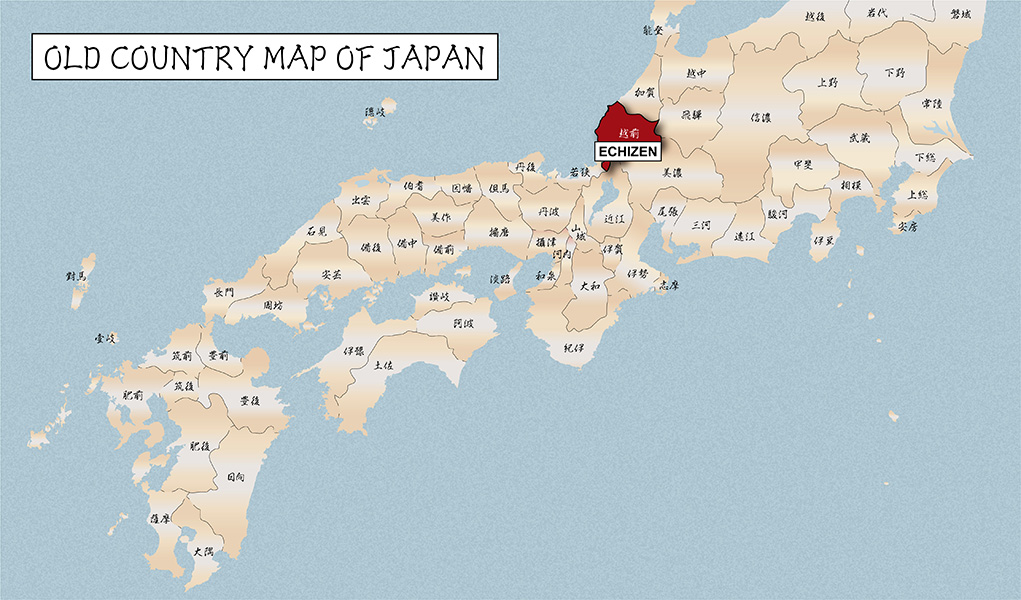
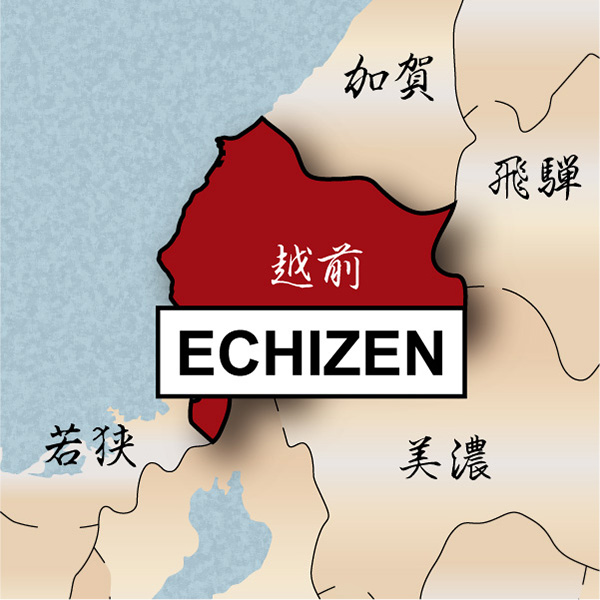
Wakizashi
This blade has the signature of Echizen no Kami Sukehiro on the front and the date (March, the fifth year of the Enpo era) is also inscribed. Enpo era in the early Edo period. There is NO provenance that proves its signature’s authenticity. However, the registration paper was issued by the board of the education in Mie for this Wakizashi. That means that Bunkacho(The Agency for Cultural Affairs) acknowledges this wakizashi as a work of art. The sword needs to be traditionally hand-forged and made of Tamahagane carbon steel to be registered in the system.
What is Daisho?
Daisho is a pair of two Japanese swords Samurai carried. During the Edo period, having Daisho in public places was considered social status for Samurai. Furthermore, Samurai were required to wear them under the law back then. Daisho is written as 大=Big and 小=Small. Dai part means Katana, and Sho part means Wakizashi. This Daisho comes with the matched sword mountings including Tsuba, Fuchi Kashira and Menuki. And, the they were appraised by NTHK this October.
【 Blade】
-Katana
Cutting Edge Length(Nagasa): 62.7 cm( 24.7 inches)
Curvature(Sori): 1.4 cm(0.55 inches)

-Wakizashi
Cutting Edge Length(Nagasa): 37.8 cm( 14.9 inches)
Curvature(Sori): 0.6 cm( 0.23 inches)

Hamon:
The crystalline structure which forms along the cutting edge of a blade as a result of the hardening process
Jimon(Jihada):
visible steel surface pattern created by folding and hammering during forging process
-Katana
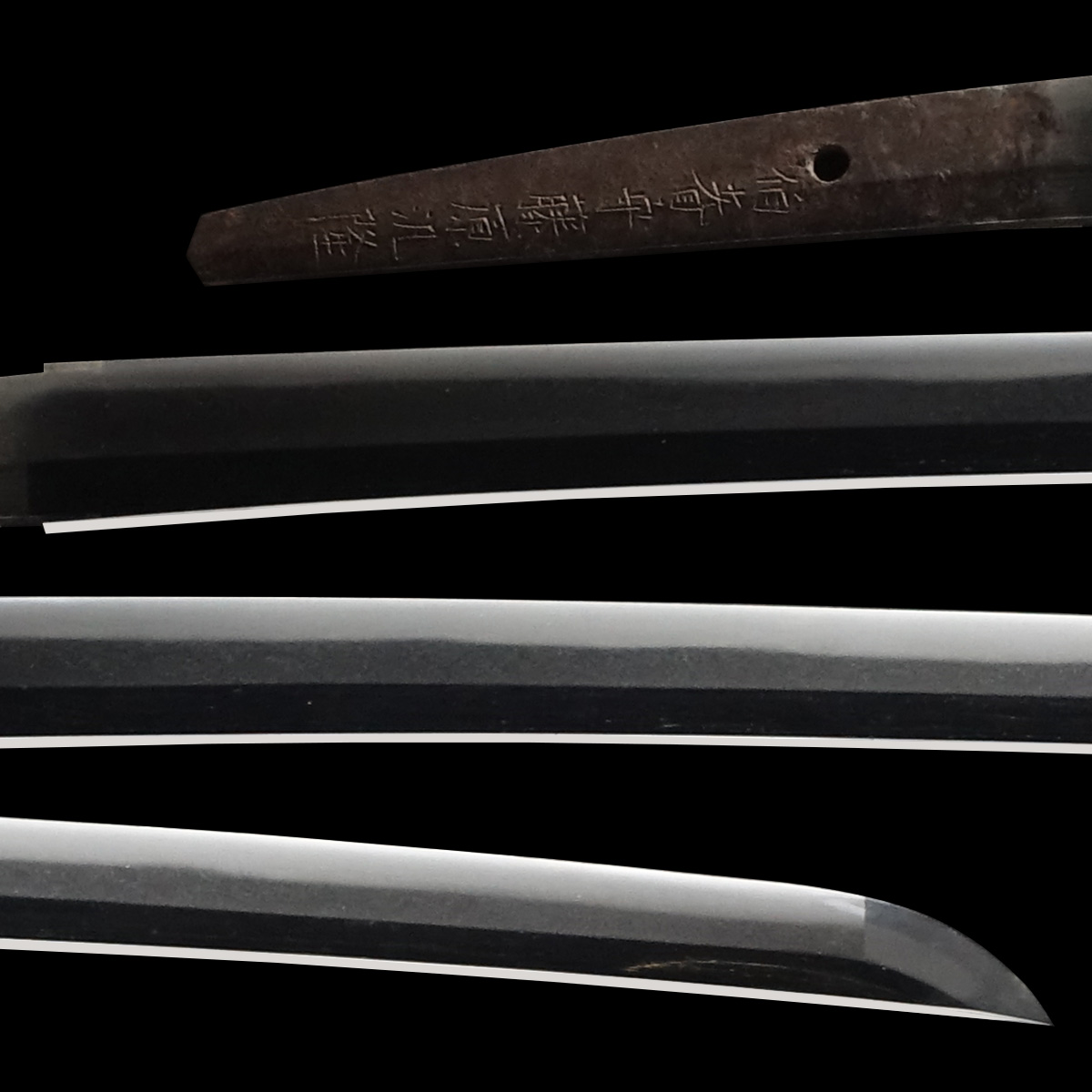
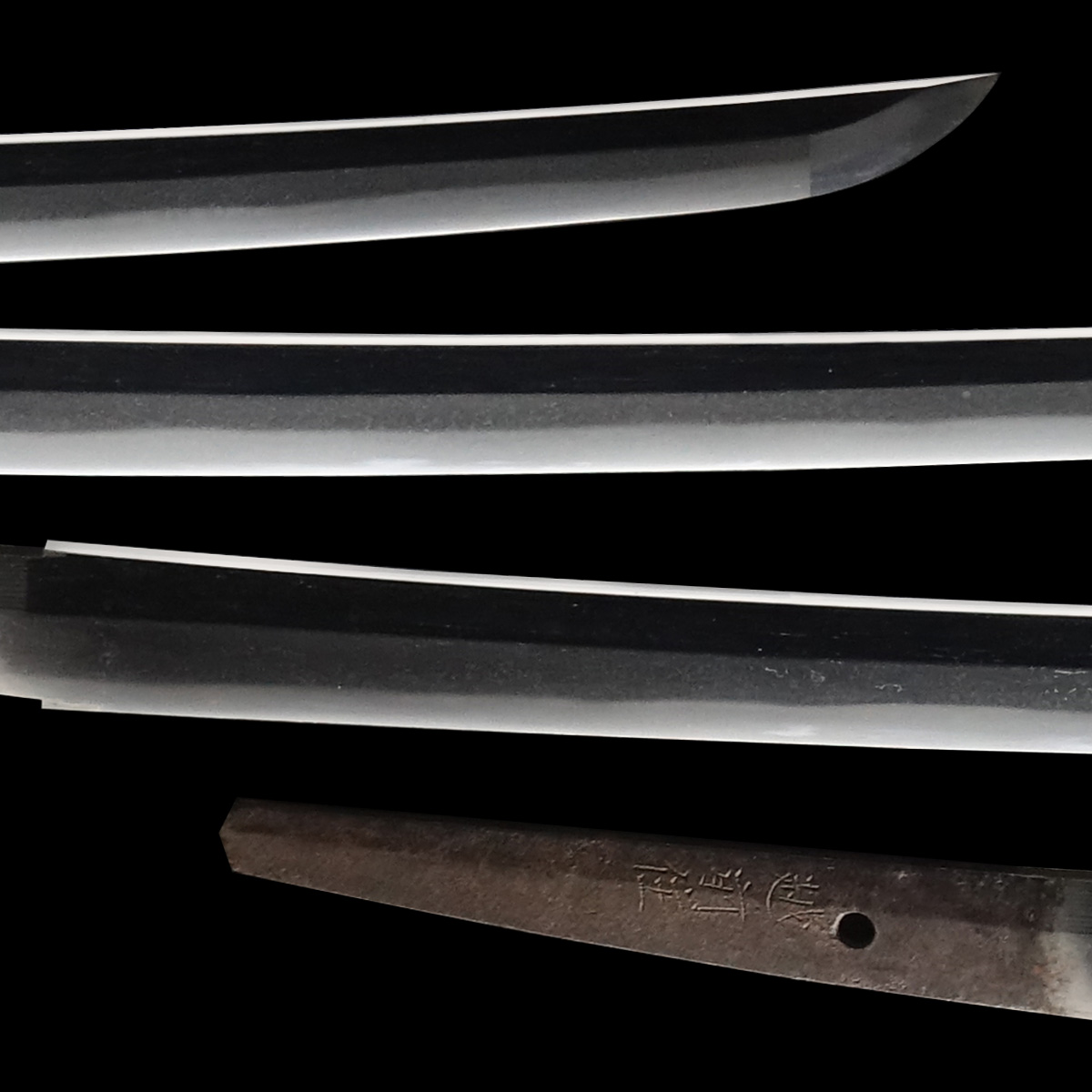
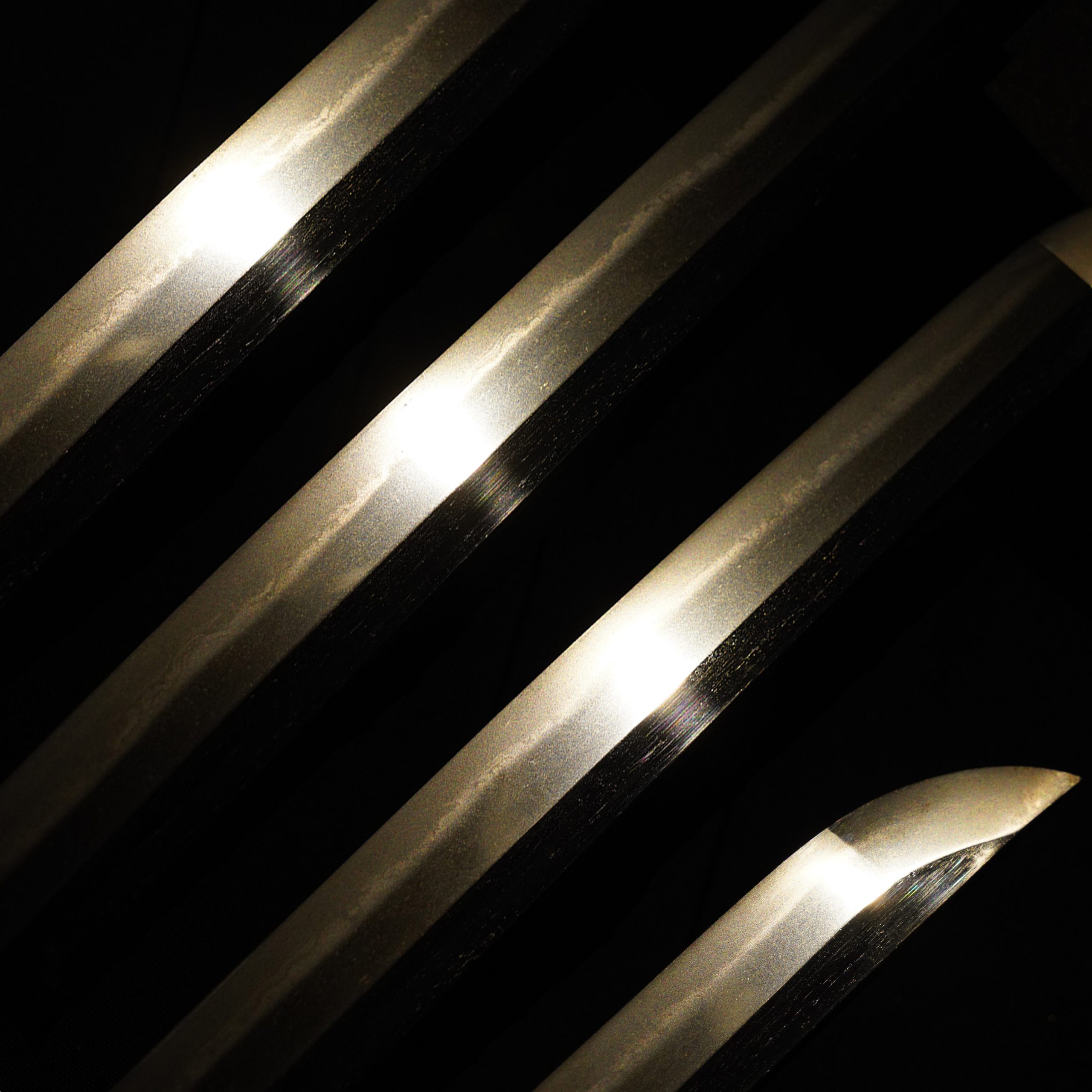
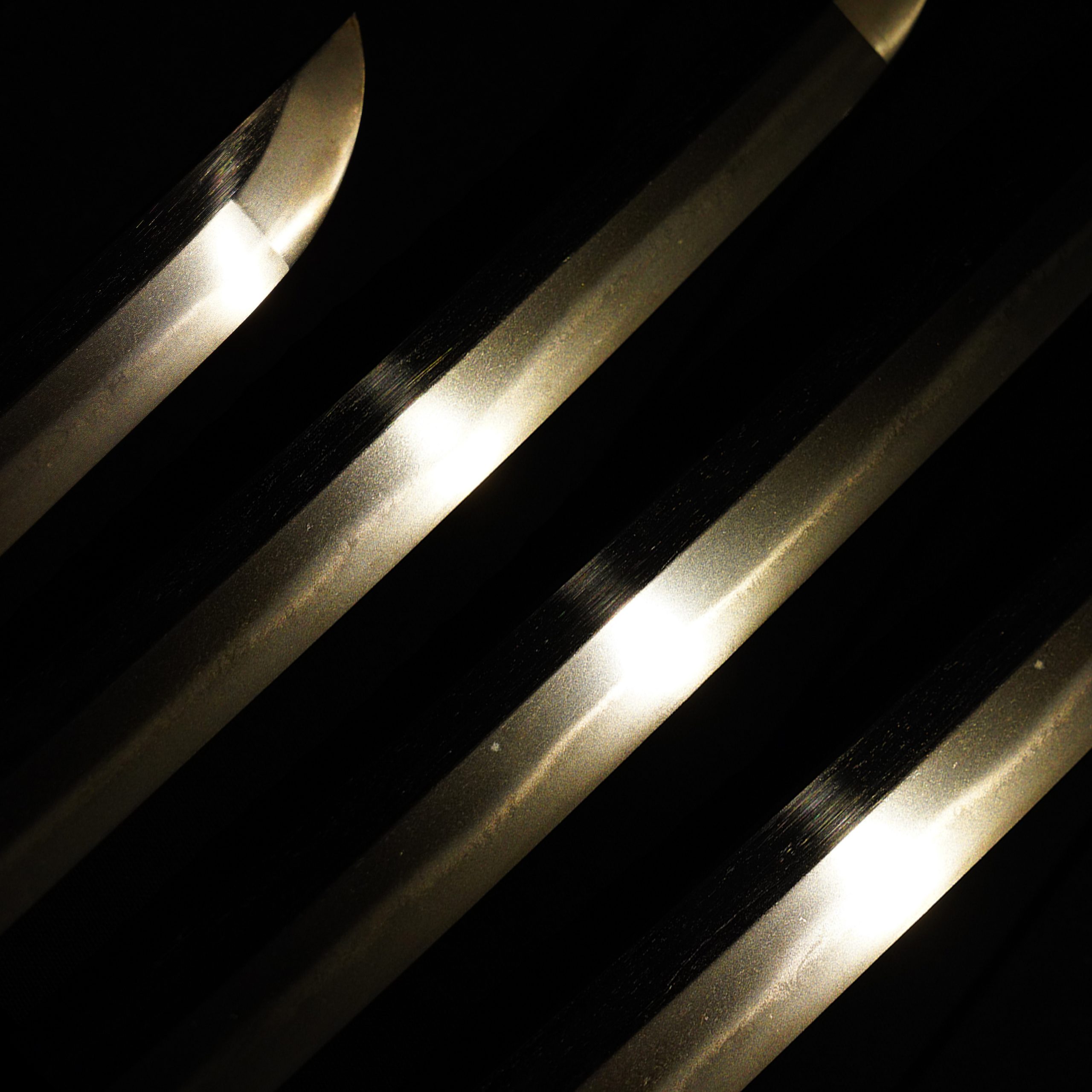
-Wakizashi
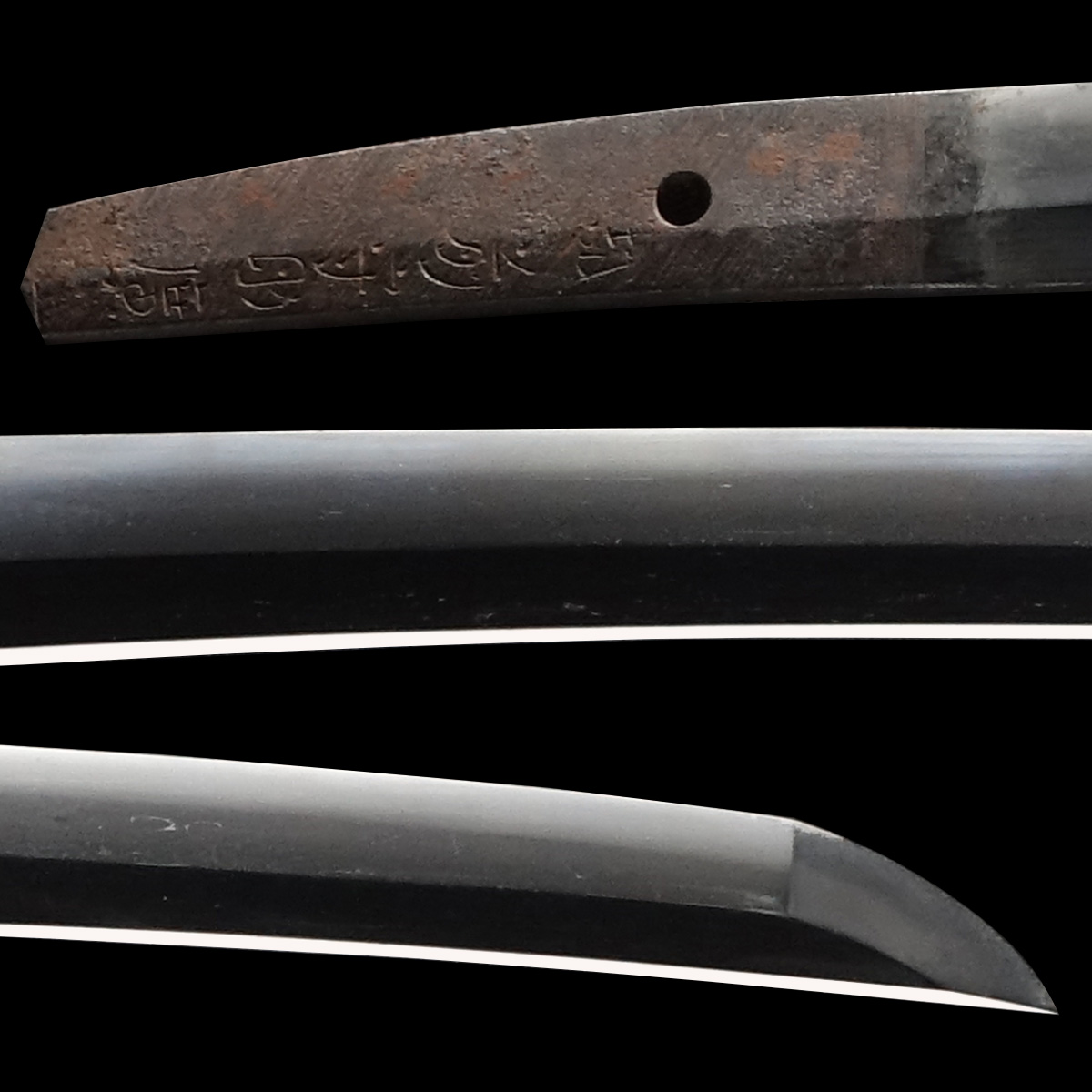
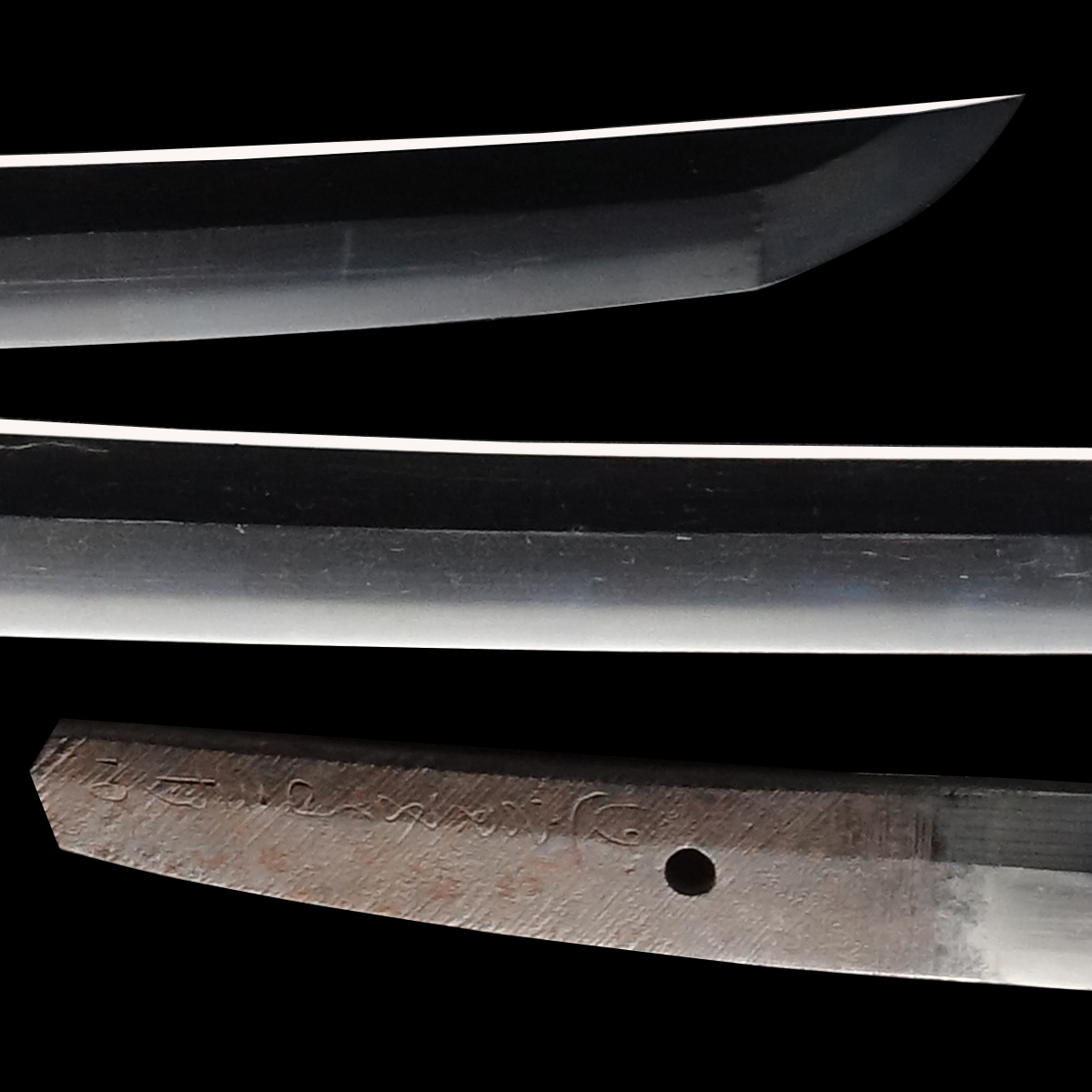
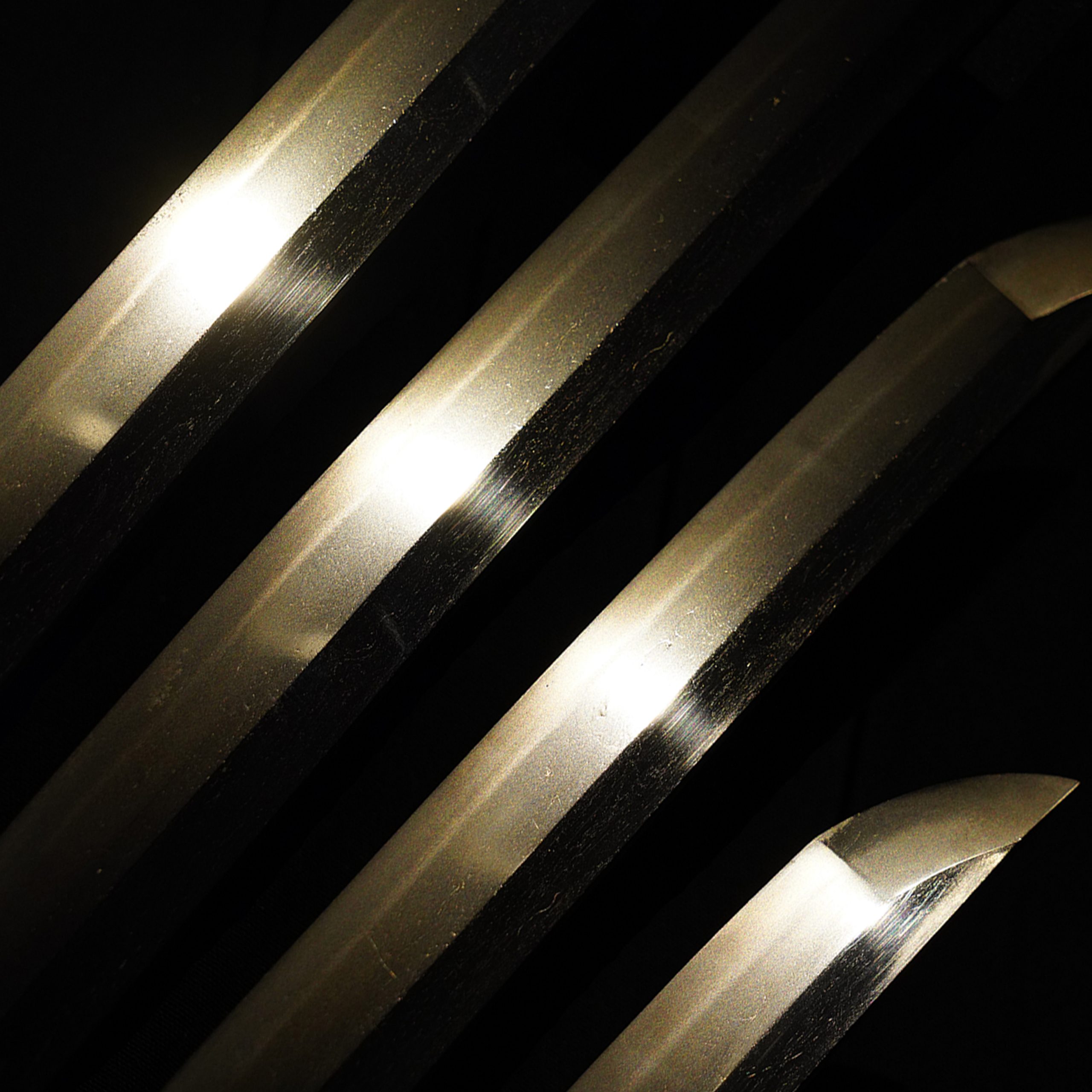
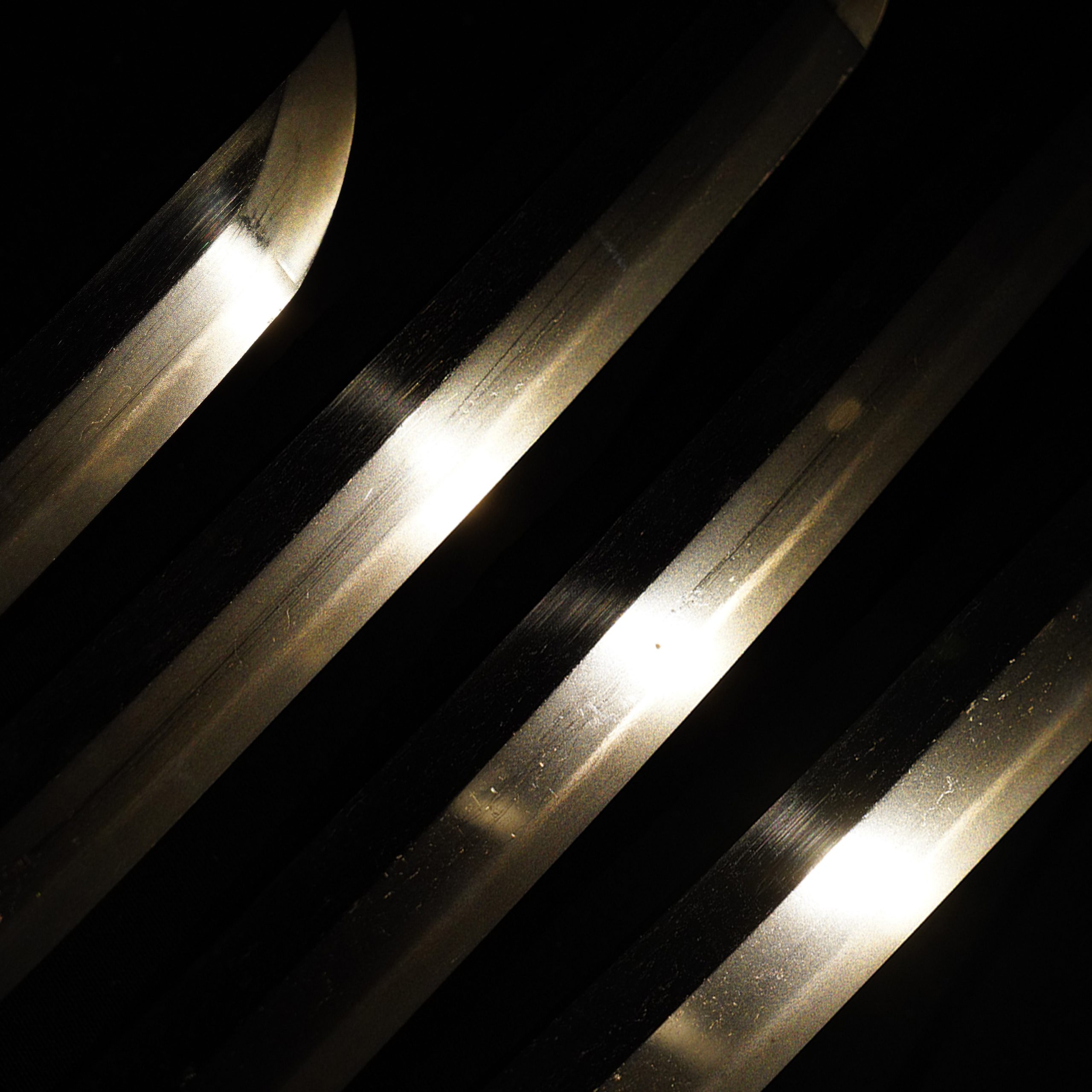
Nakago:Nakago is the tang of the Japanese sword.
Japanese swordsmiths left the black rust on the tang because it prevents red rust while the tang is in its handle. And the discoloration of the tang was created over time, and it is a great indicator for a Japanese sword specialist to estimate when the sword was forged.
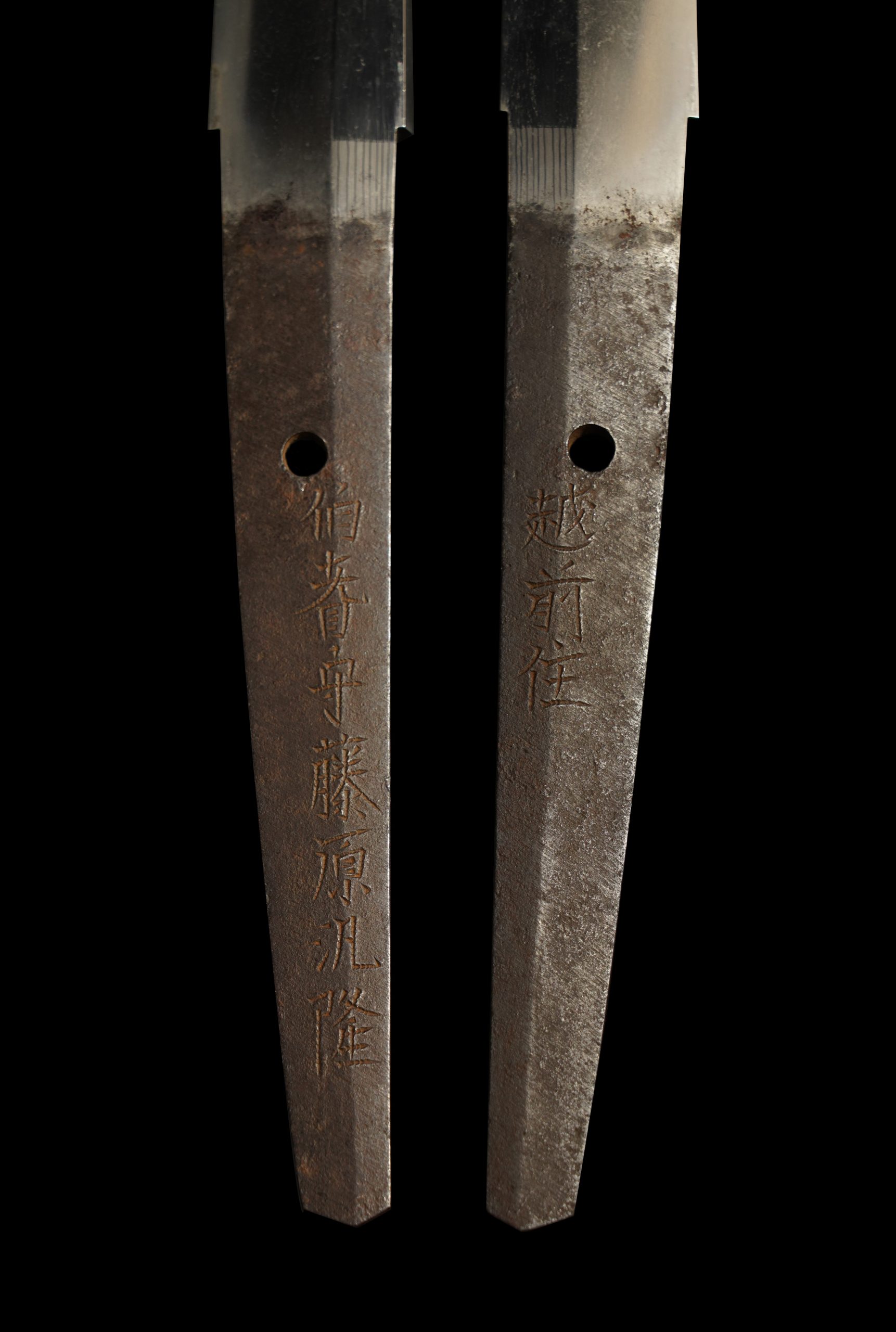
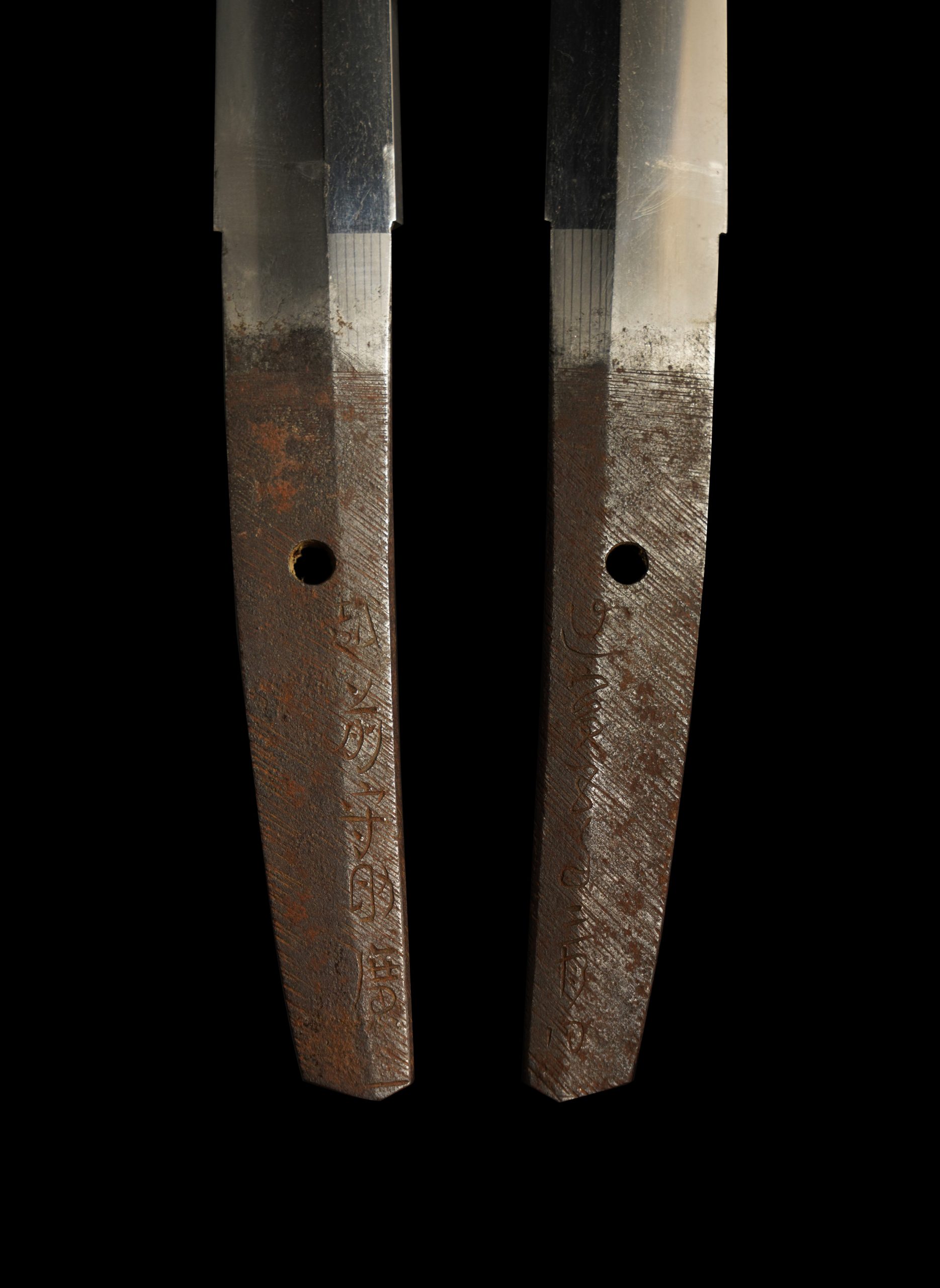
Koshirae: Koshirae is the mounting of the Japanese sword. There are several parts that consist of Koshirae such as Saya(Sabbard), Tsuka( Handle), Tsuba(Handguard).
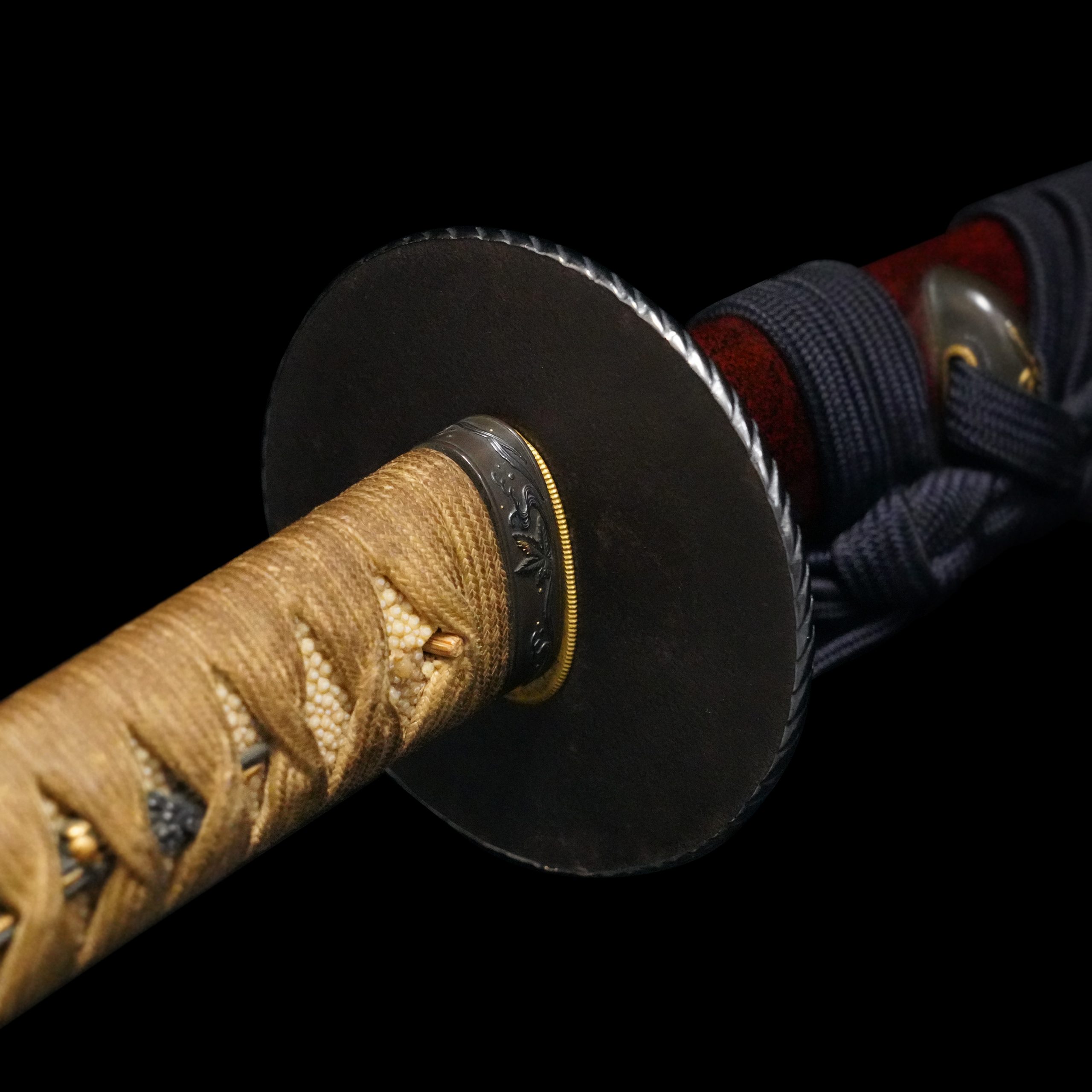

Fuchi-Kashira:A pair of matching sword fittings that cover the upper and bottom parts of its sword hilt.
The Ryusui Momiji (流水紅葉) design decorates these Fuchi Kashiras. It depicts a scene that maple leaves run into the water. This design is also called the Tatsuta Gawa (竜田川, Tatsuta river) pattern. The Tatsuta River is a first-class river that flows through Ikoma City in Nara Prefecture. This place is well known as a spot for autumn leaves. Maple leaves change their colors into red, orange, or yellow beautifully and flow into the water; there is something quaint about this scene. It has been one of the familiar views for Japanese people since ancient times.
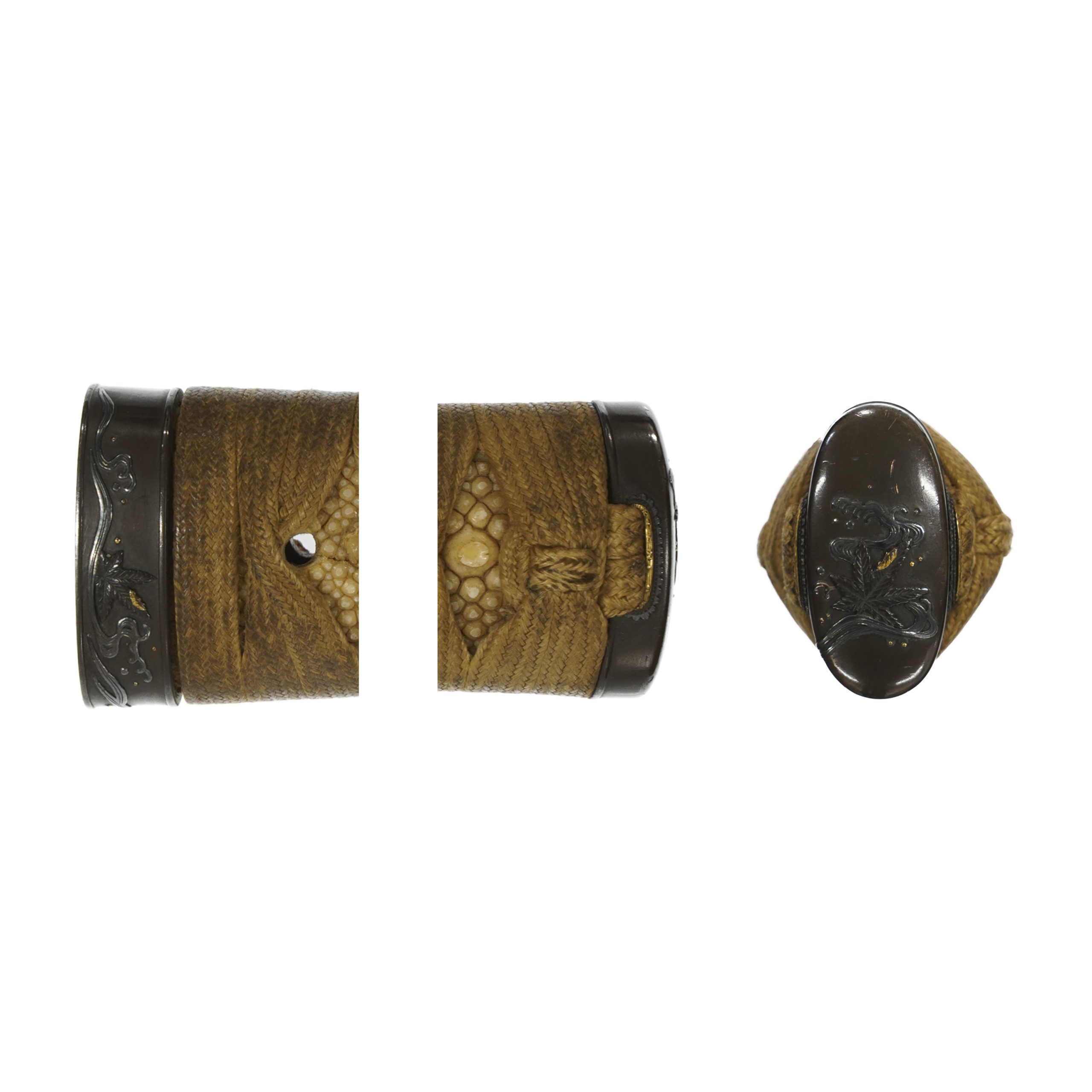
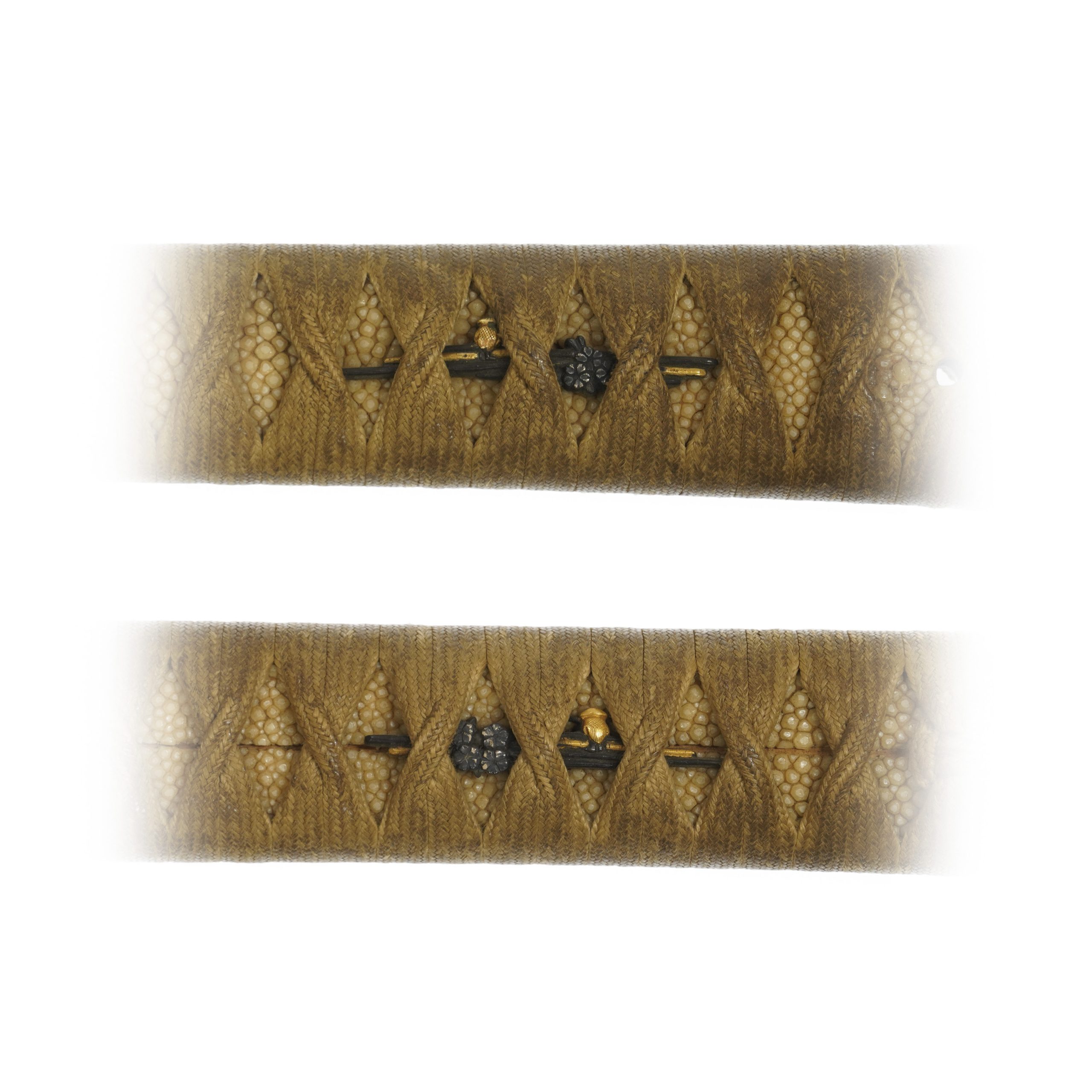
Tsuka and Menuki:Tsuka is the handle of the Japanese sword and Menuki is its decoration.
These Menukis’ motifs might be a scene of the waterside. You could find small flowers through the gaps of Tsukamaki thread. It might be cherry blossoms. It is one of the seasonal things of spring, and it has been loved for a long time in Japan. Its pattern is designed not only for sword mountings but also for Kimono (着物, traditional Japanese costume) or furnishings. One theory says that the god of grain exists in cherry blossoms. Therefore, this flower pattern has been treated as the symbol of a plentiful harvest. On the opposite side of the flowers, you would find something that is colored with gold. We guess it depicts a fisher because it looks this person brings a rod. Same as Fuchi Kashiras, these Menukis have the common theme; the water’s edge.
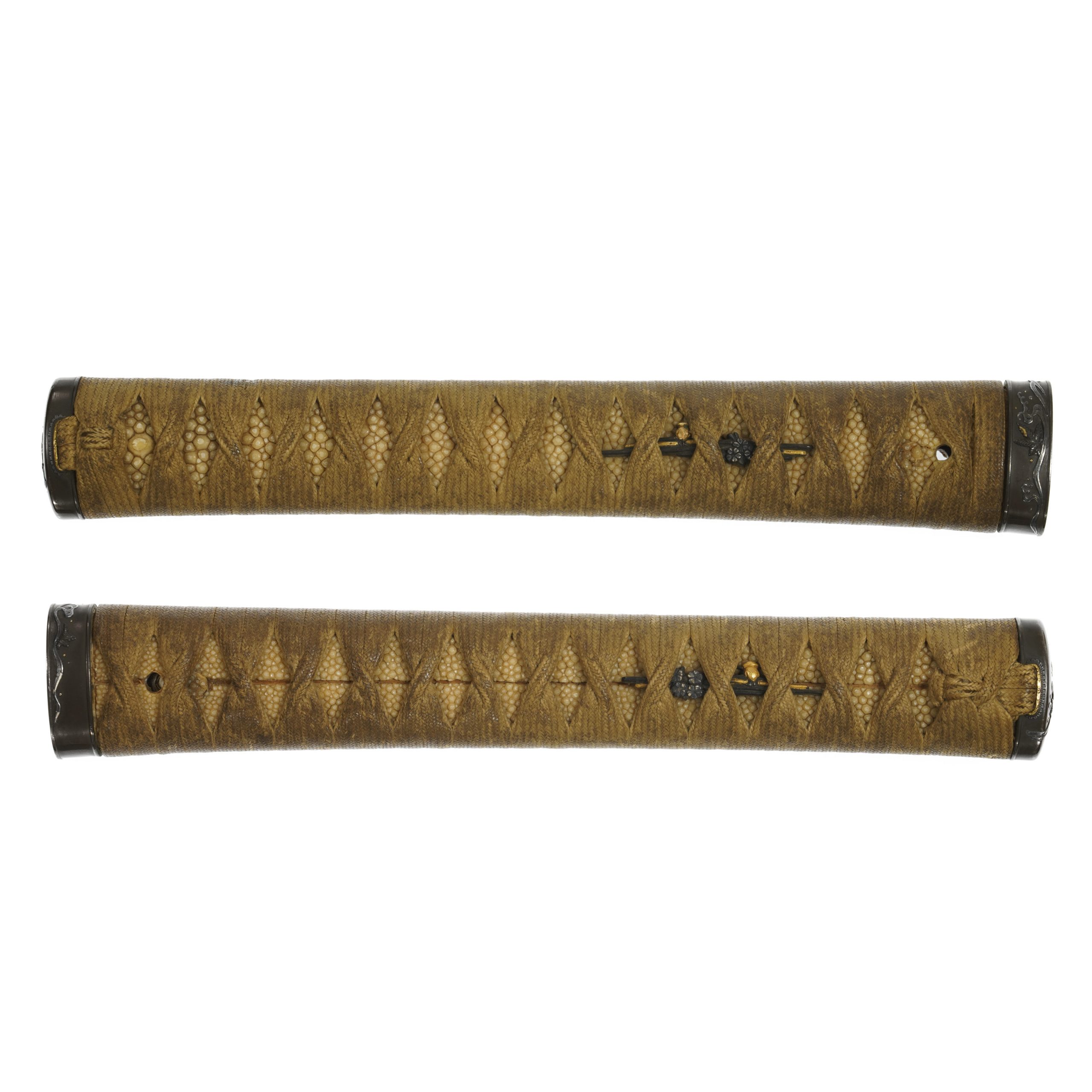

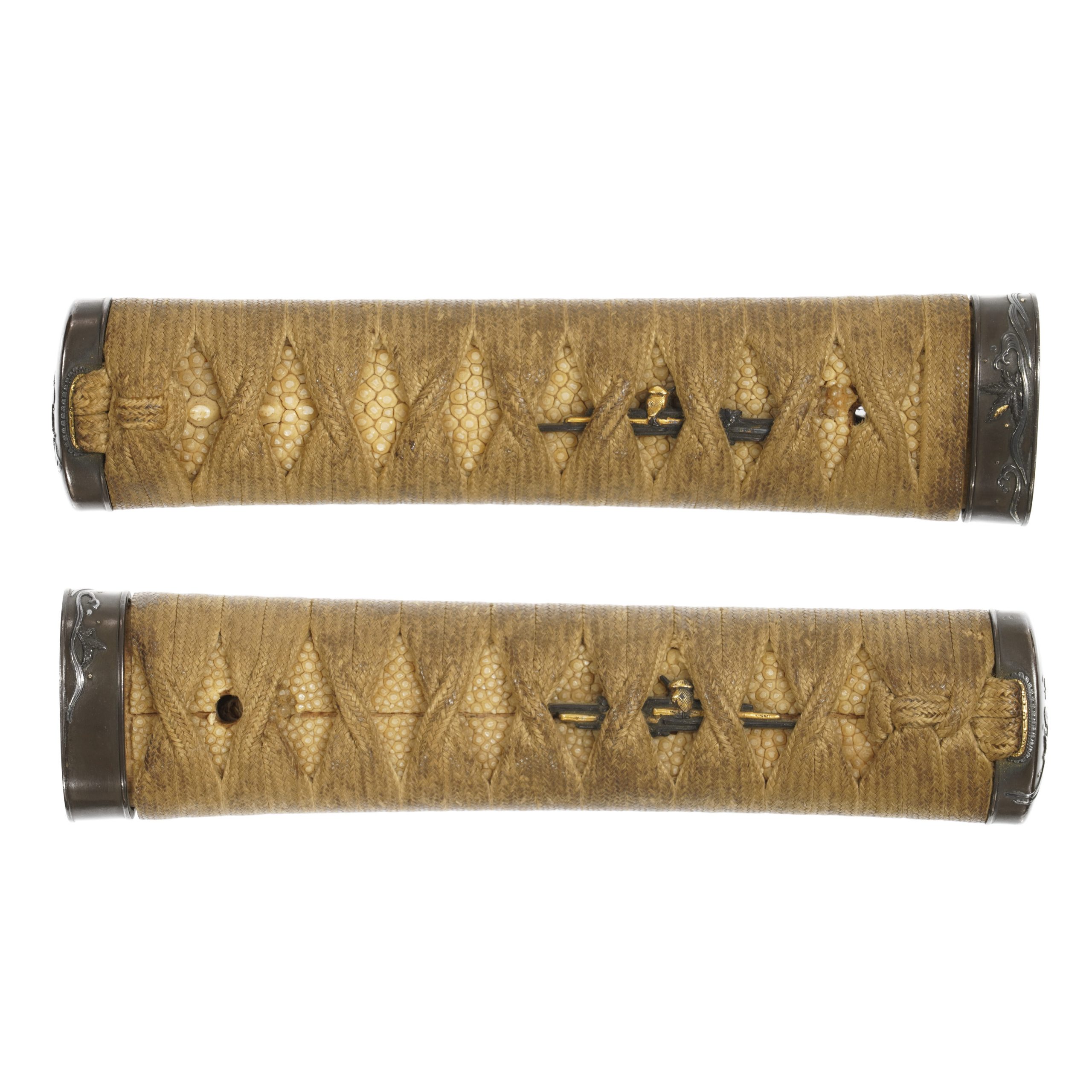
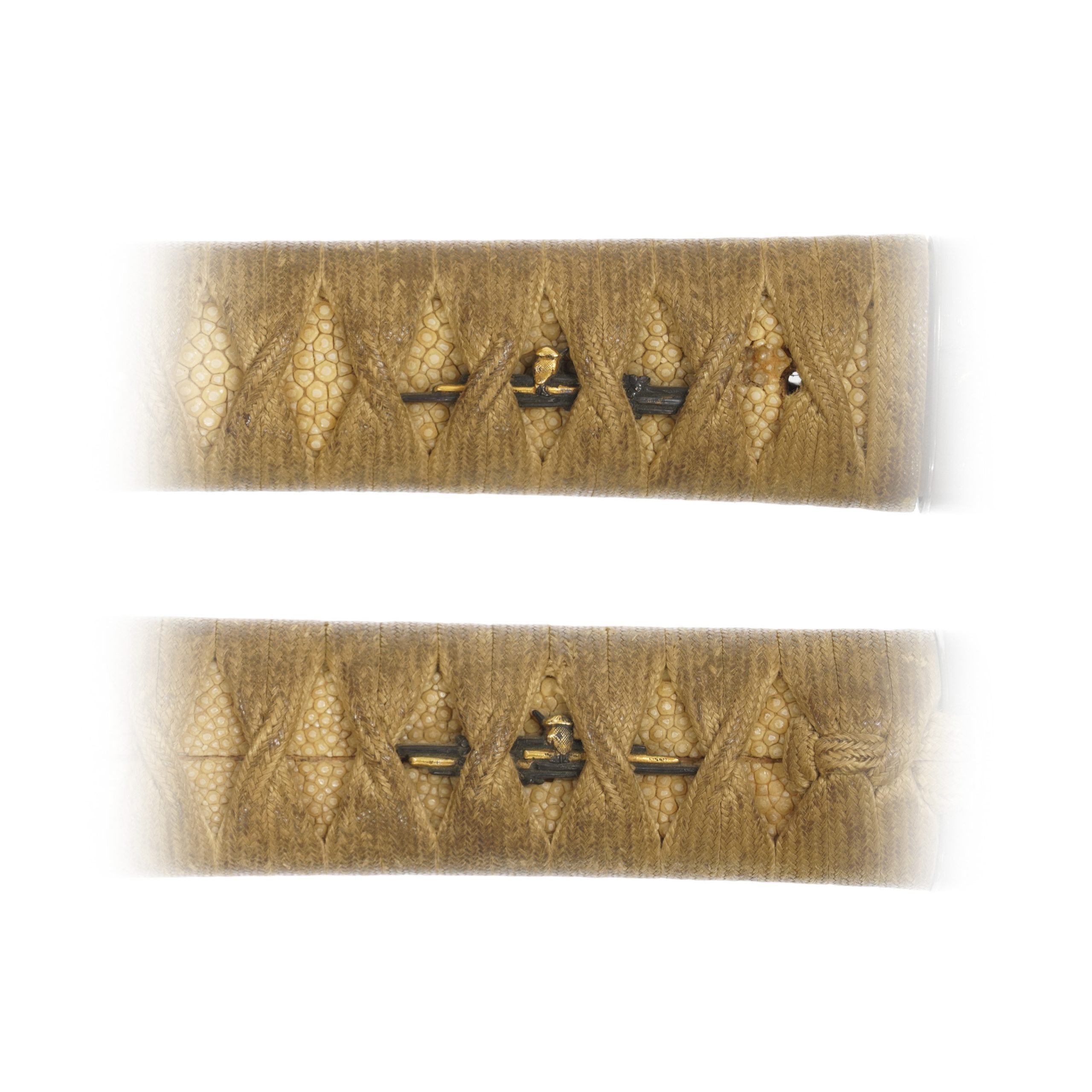
Tsuba and Habaki:Tsuba is the handguard for the Japanese Sword and Habaki is the equipment to make the blade not touch its scabbard inside. It prevents the blade from getting rusty and chipped.
Circle-shaped Tsubas made from iron. The edges of these Tsubas are framed with a silvery metal plate, and it has a rope pattern. This edge decoration gives an ornamental look to these works. And it also has practicality, such as preventing the wear of the edge part. Moreover, it prevents the wear and tear of the Kimono if the edge damages it by touching the cloth. Although it is not easy to see due to aging, there are signatures of these Tsubas’ maker at the side of the center hole. It is written as 國安 (Kuniyasu).
These Tsubas’ simple design matches with other sword mountings when they are put into the handle. We hope you would enjoy the blade itself and also the Koshirae part.
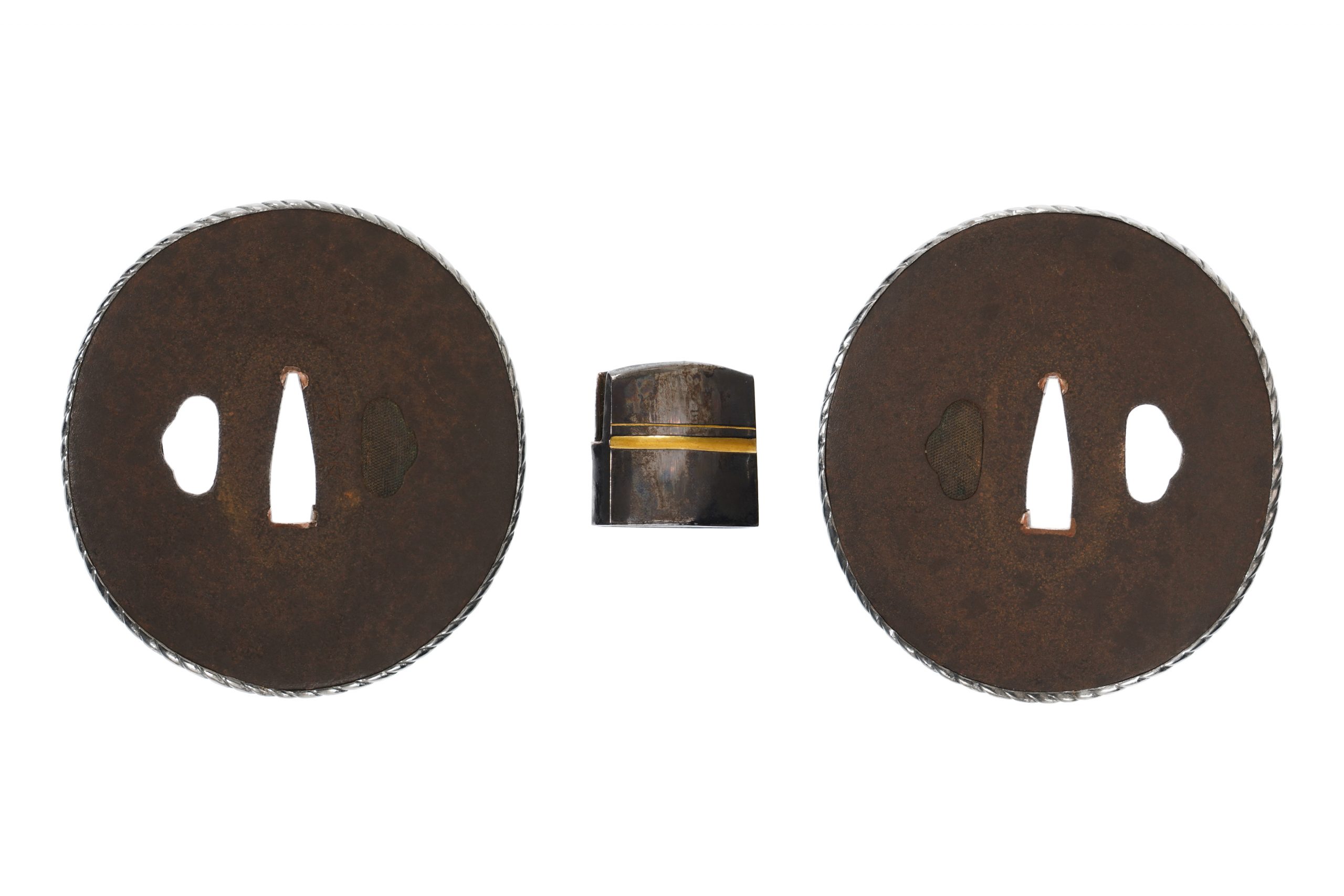
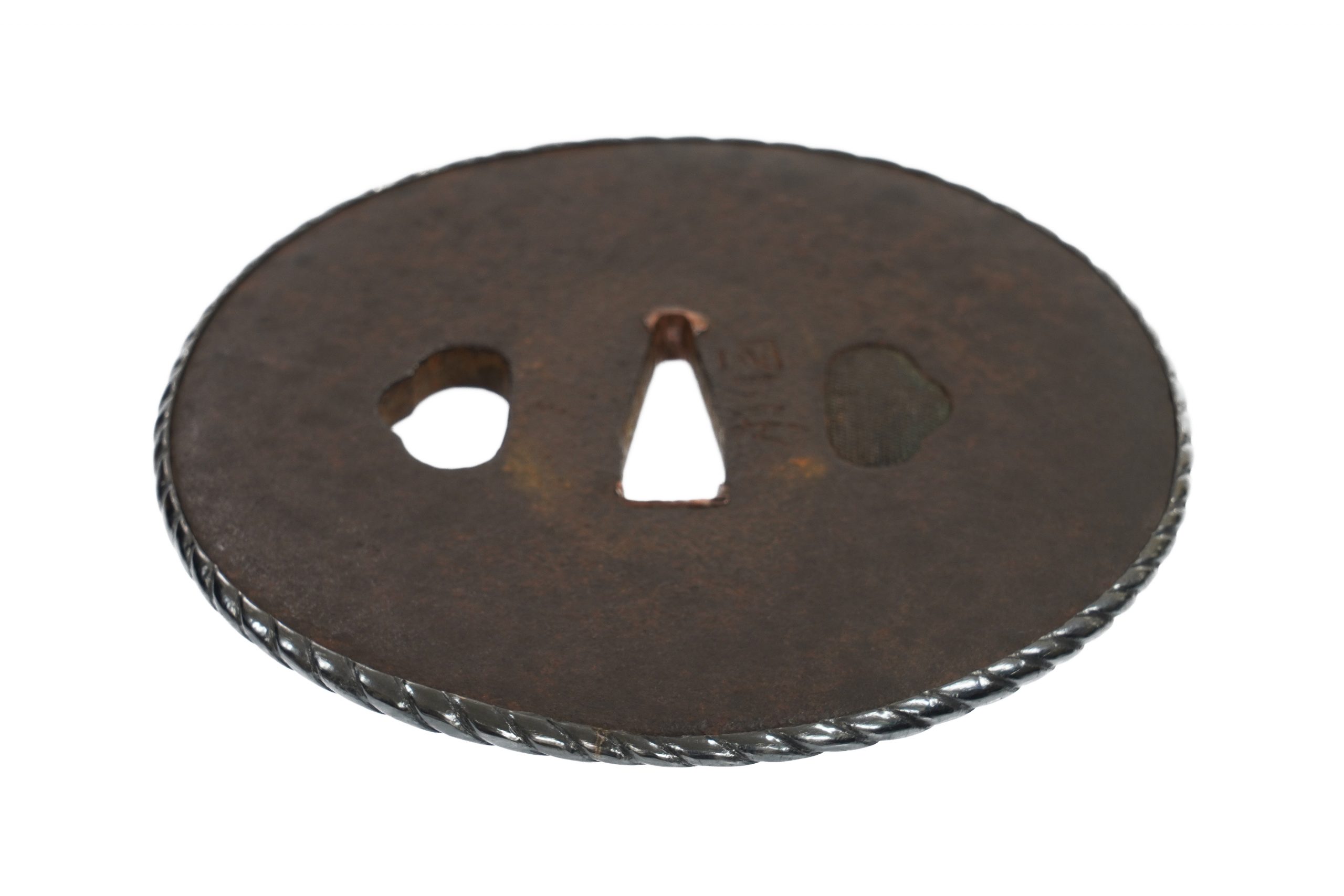
Saya: Saya is the scabbard for the Japanese sword.
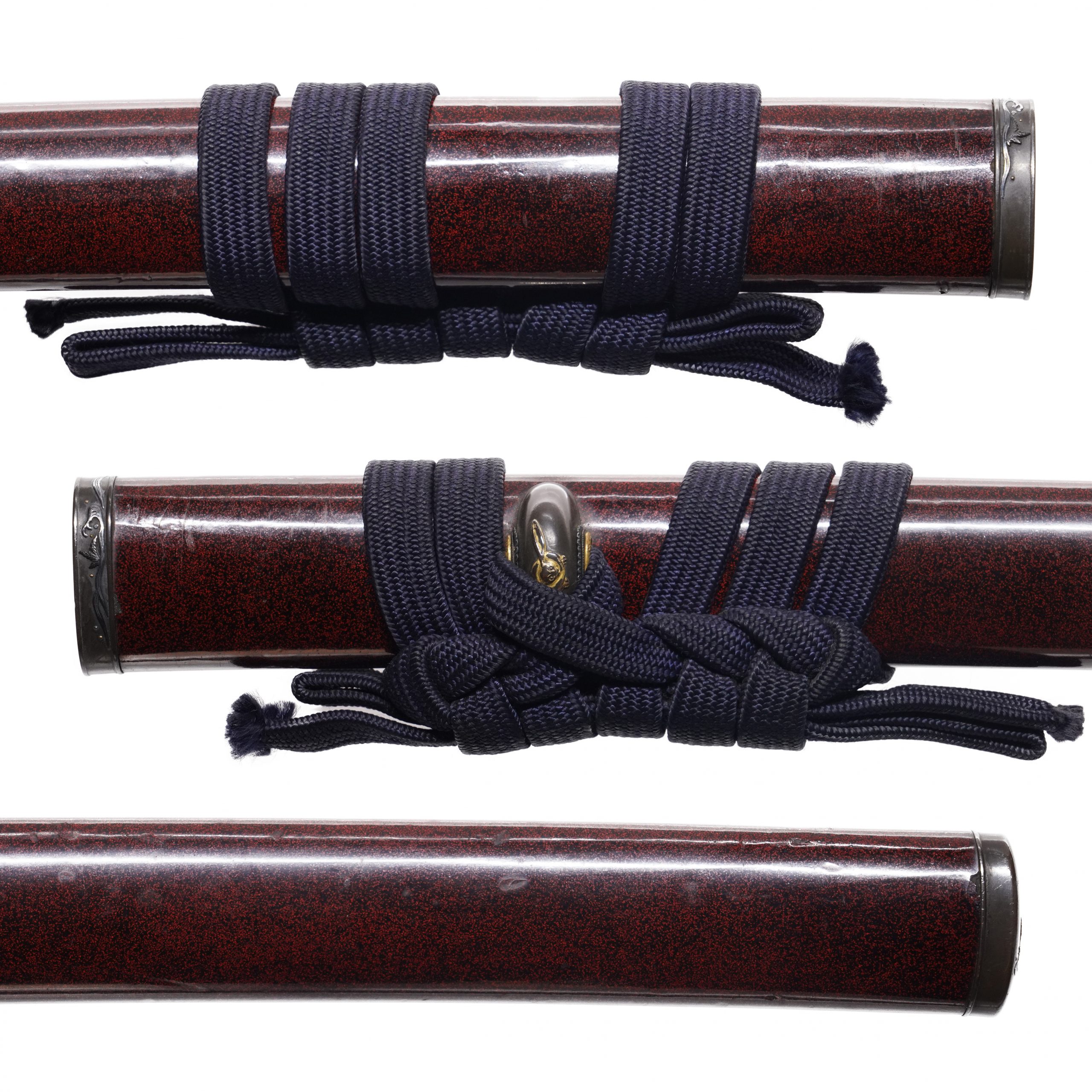
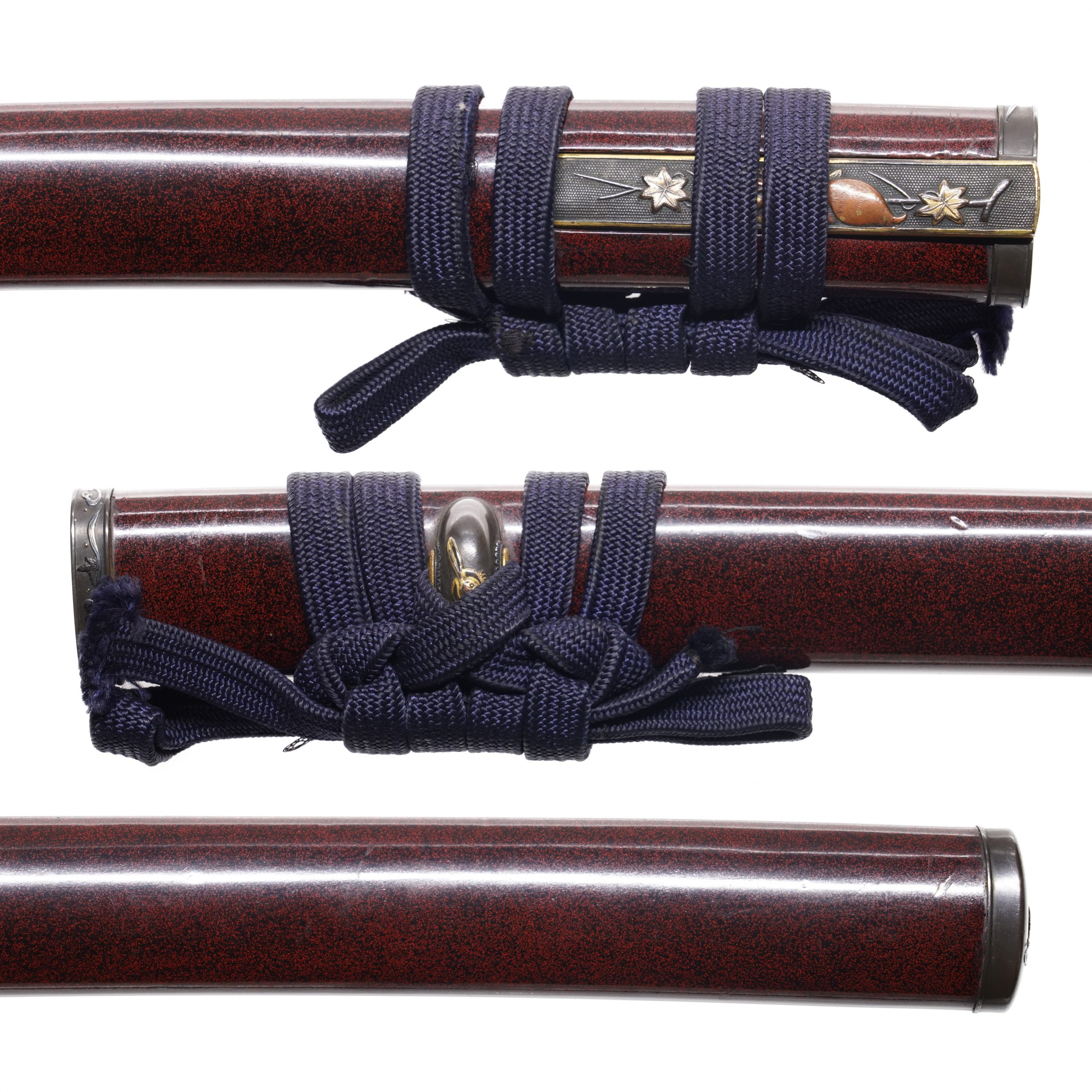
Kozuka:Kozuka is a small knife stored in Koduka Hitsu(groove of the sheath of the Japanese sword).
The Kozuka is put into the Wakizashi’s Tsuka. As you could see, the Kogatana (tiny knife) is stored in this Kozuka. A deer is taking a rest, and you could find maple leaves around it. This combination is called the Shika Momiji (鹿紅葉, deer and maple leave) pattern. It has been treated as an auspicious design. This theme also symbolizes autumn same as the Fuchi Kashiras’ motifs of this Daisho Koshirae.
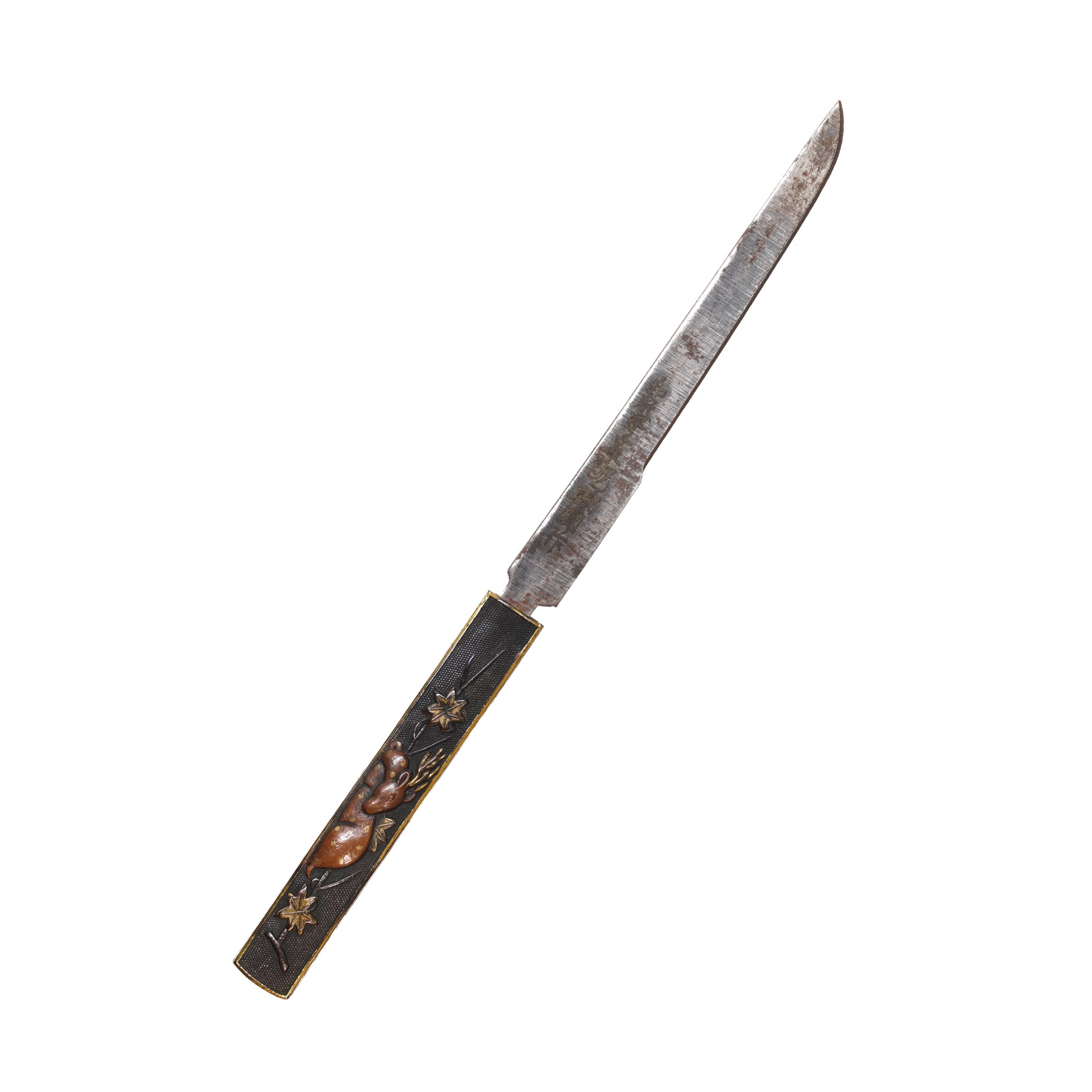
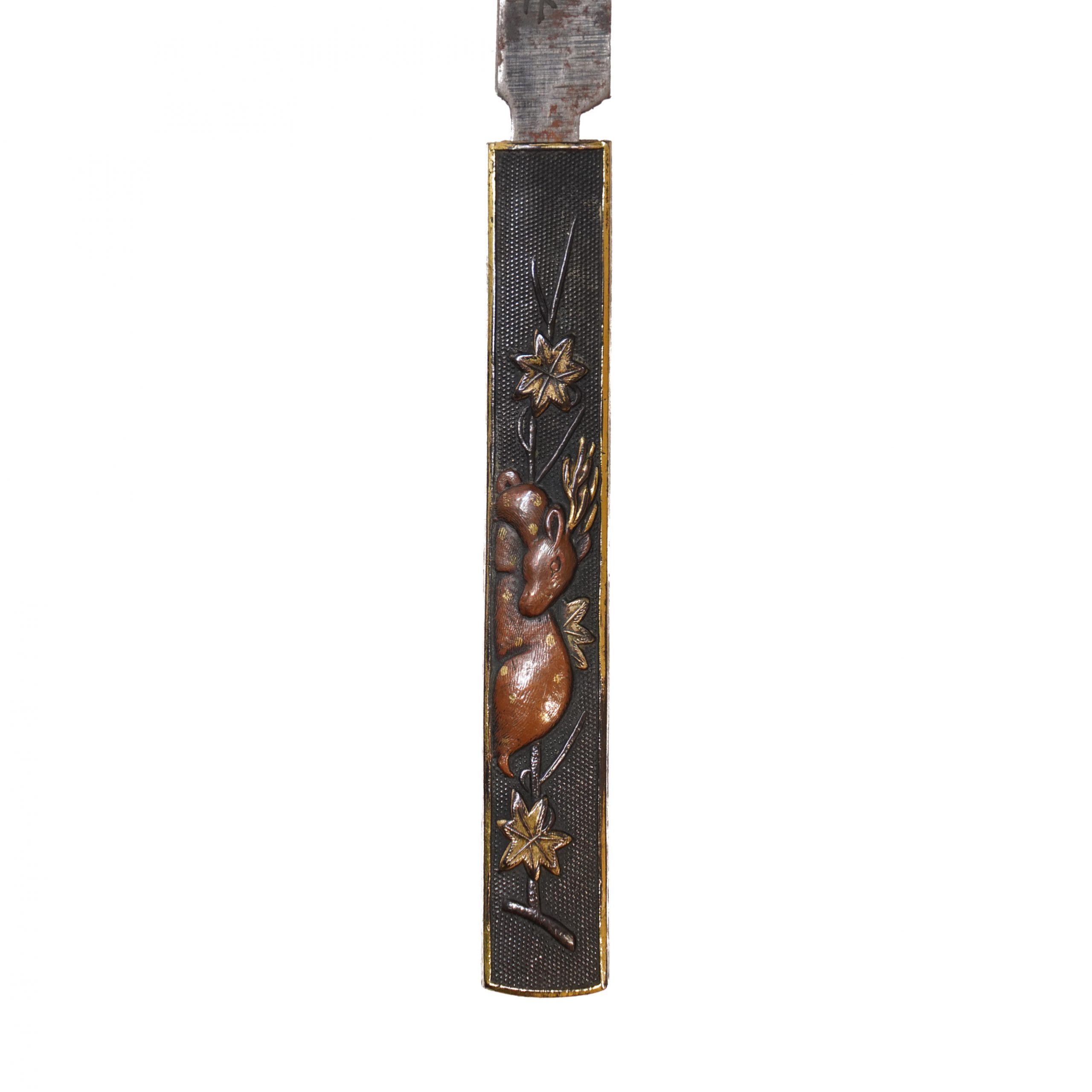
Authentication Paper:NBTHK Tokubetsu Kicho Certificate for the Katana& Its sword mounting
NBTHK, also known as Nihon Bijutsu Touken Hozon Kyokai (the Society for the Preservation of the Japan Art Sword), is one of the oldest Japanese sword appraising organizations in modern-day Japan. They authenticated the Katana blade on June 28th in the 39th year of Showa (1964). They appraised it as Tokubetsu Kicho Touken, an old form of a certificate. NBTHK also appraised its sword mounting on Nov 27th in the 41st year of Showa(1966). The purchaser will receive these original certificates as well. We can also translate what is written into English and make a PDF file for your record if you request.
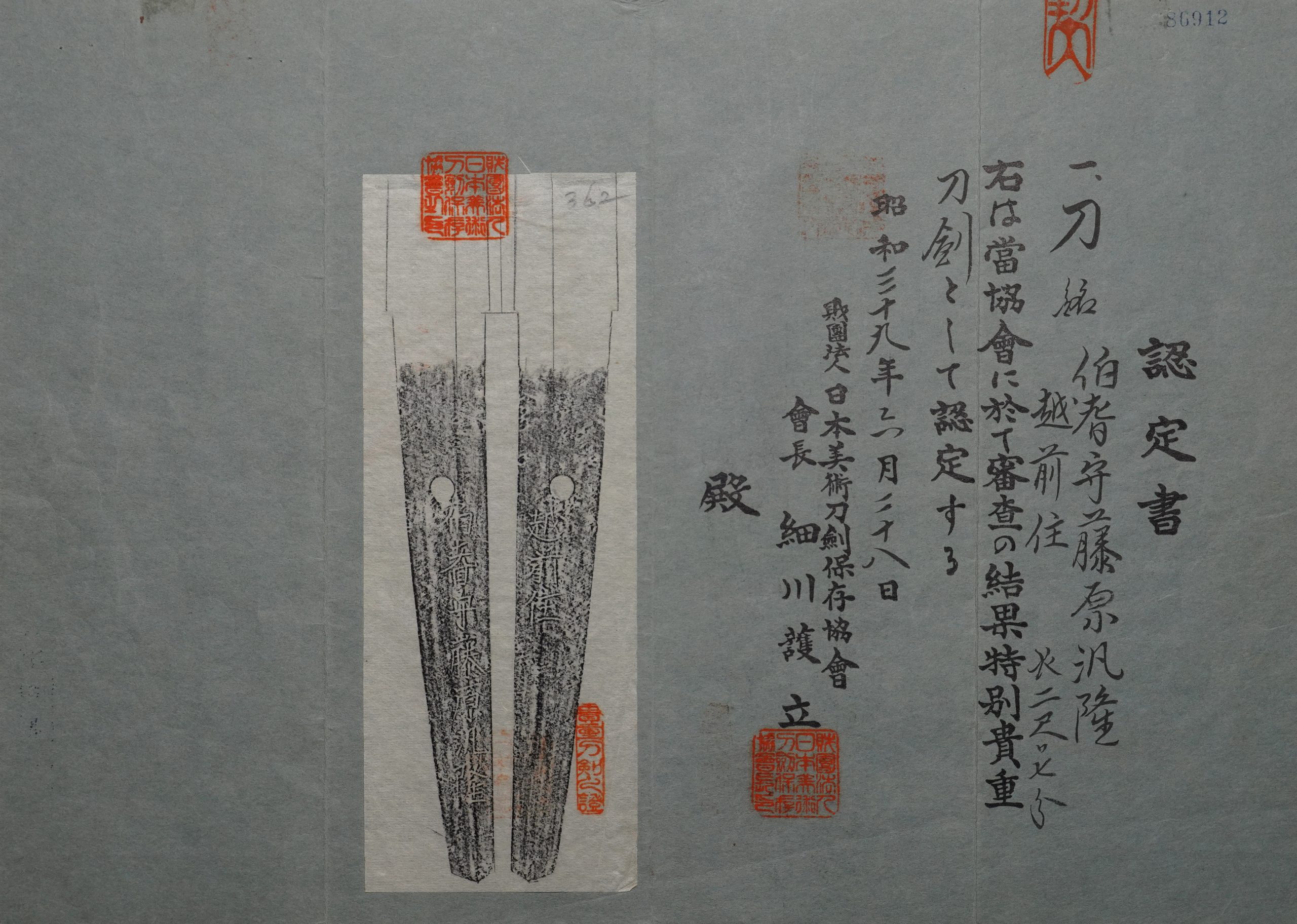
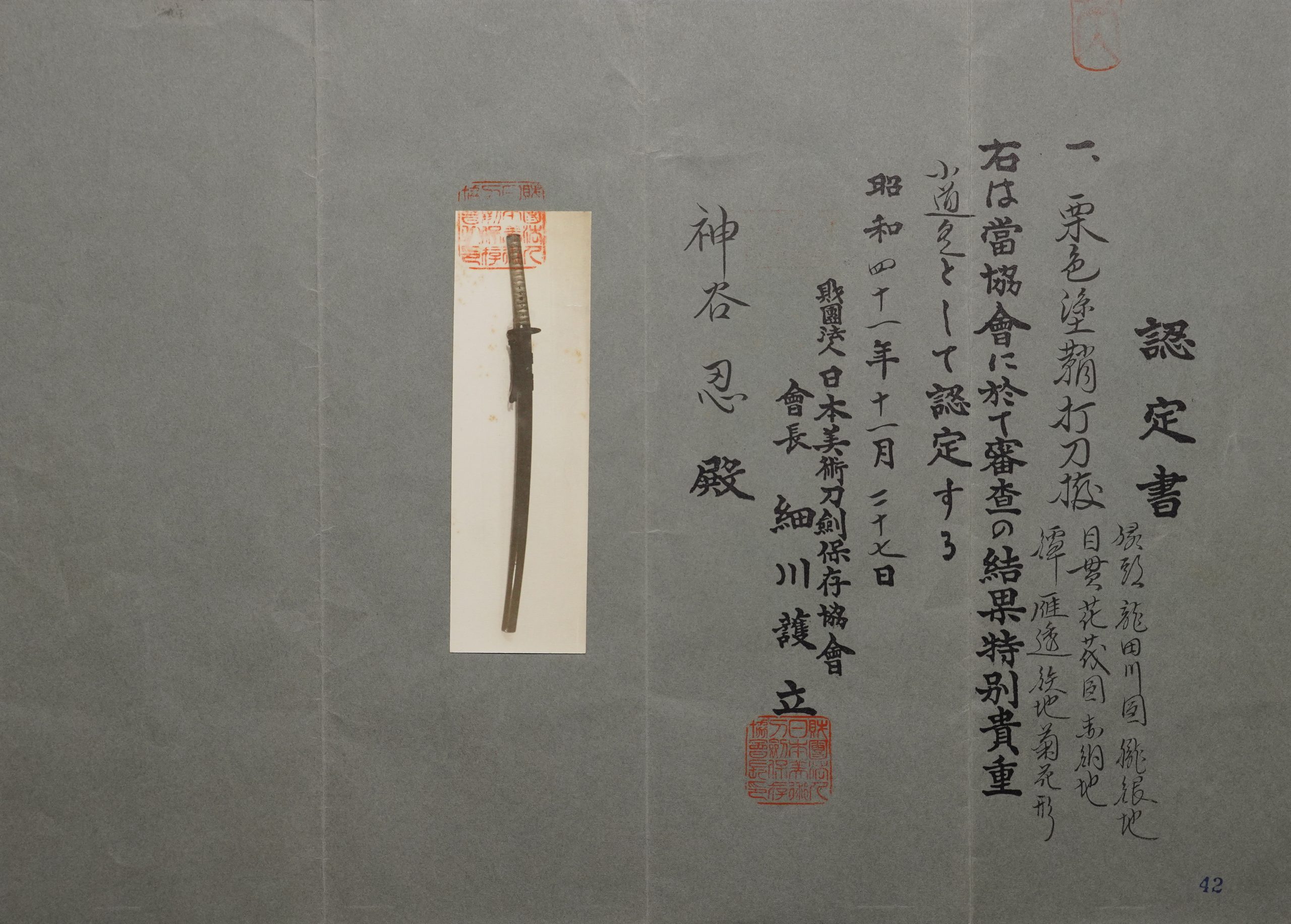
Authentication Paper:NTHK Kanteisho Certificate for the Daisho Koshirae
NTHK, also known as NPO Nihon Touken Hozon Kai, is the oldest organization for sword authentication of Japanese swords in modern times. It was established in 1889 during the post-Samurai era. They authenticated the Daisho Koshirae in 17th of October, the 3rd year of Reiwa (2021). The purchaser will receive the original certificates as well. We can also translate what is written into English and make a PDF file for your record if you request.
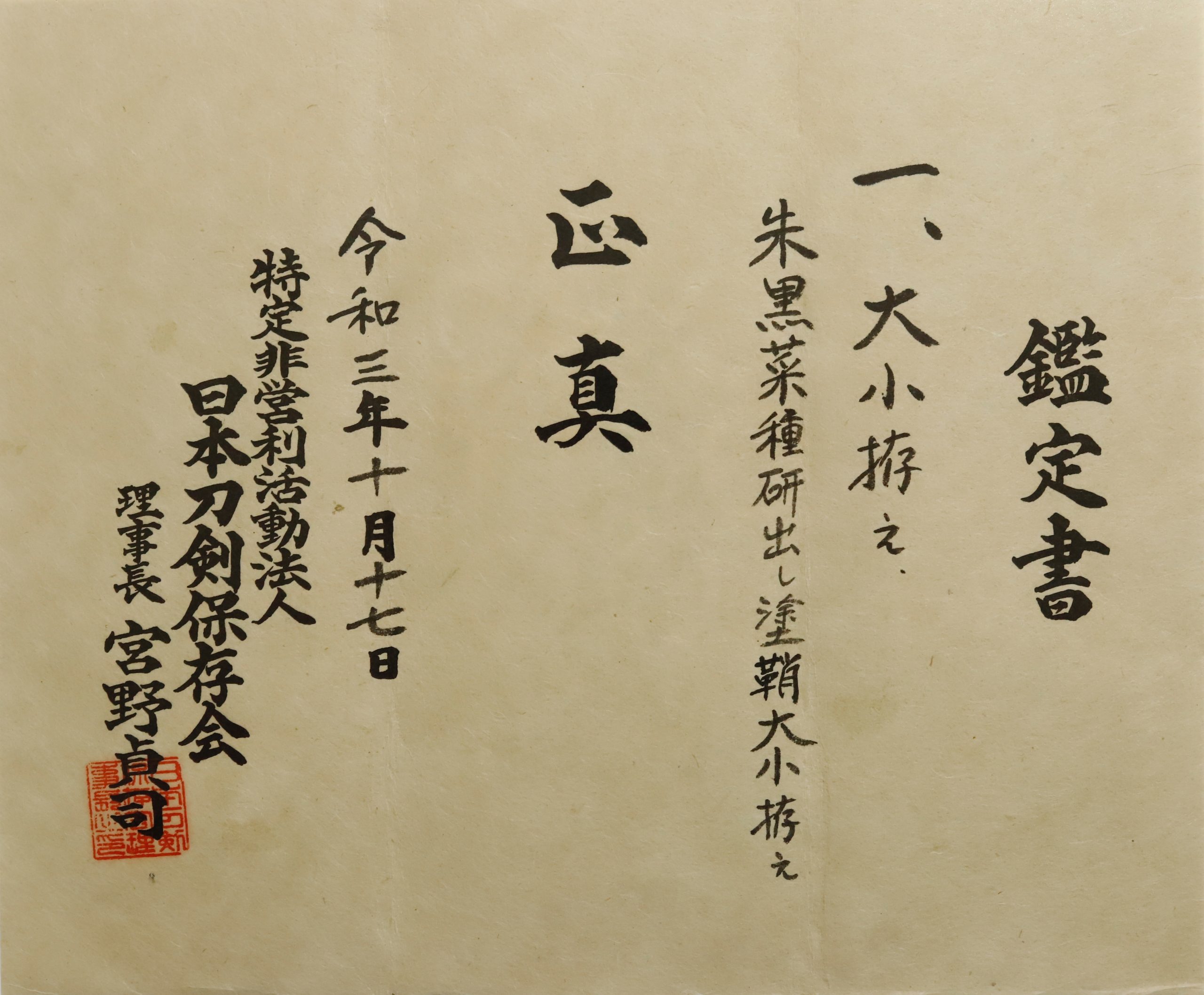
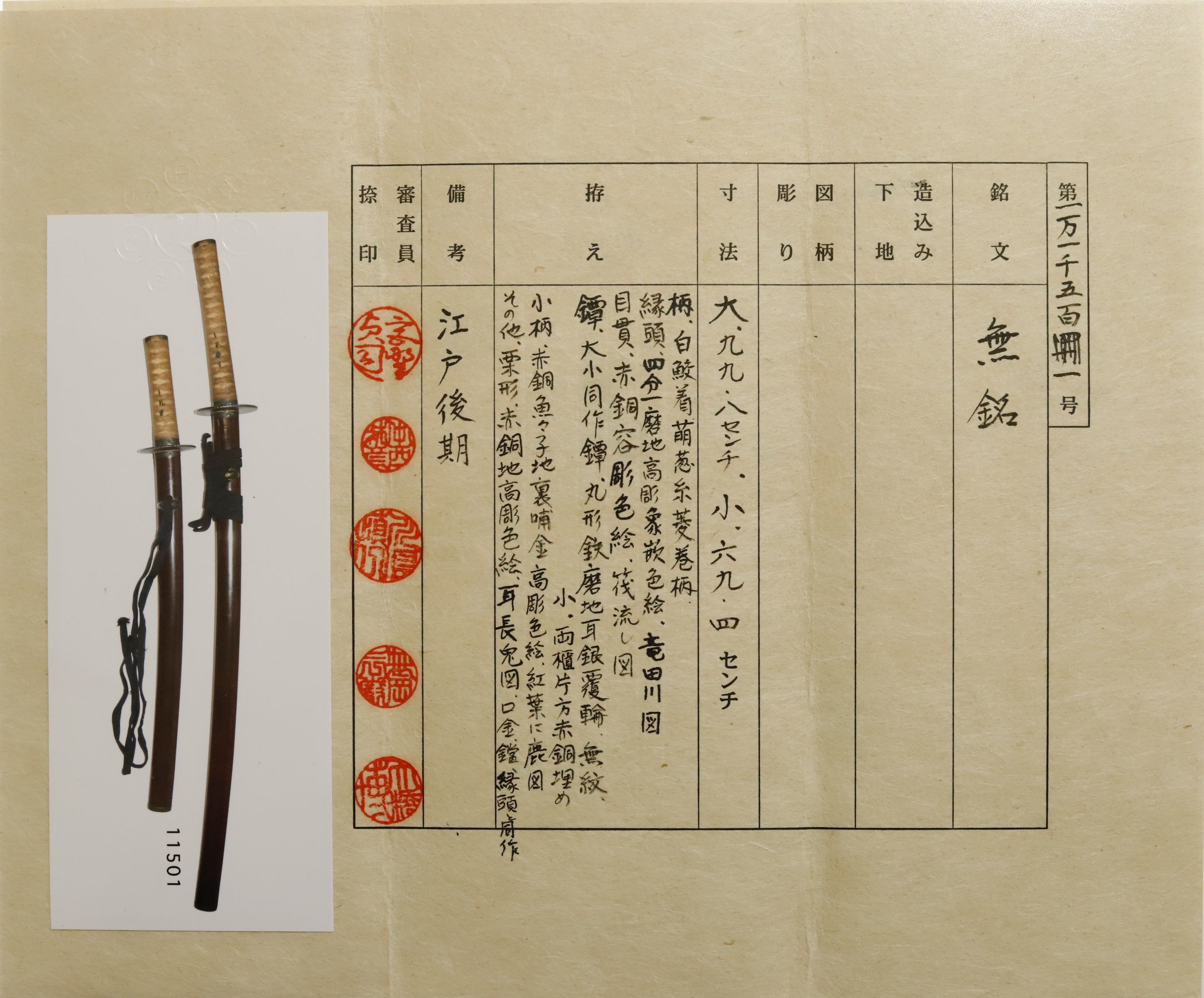
Registration Number : Shizuoka32172, Mie 20234
The Board of Education in Shizooka prefecture issued a registration paper for the Katana blade while Mie counterpart issued the paper for the Wakizashi . It is called Jyu Token Rui Torokusho(銃刀剣類登録証). Bunkacho(The Agency for Cultural Affairs) acknowledges a Japanese sword with this paper as a work of art.
The sword needs to be traditionally hand-forged and made of Tamahagane carbon steel to be registered in the system. With this paper, its owner in Japan can legally own an authentic Japanese sword. Based on this registration number, we will apply for its export permit.
This paper will need to be returned to the board of education when the sword is being shipped abroad, but you can receive a copy of it. An English translation of this registration paper is available on request.
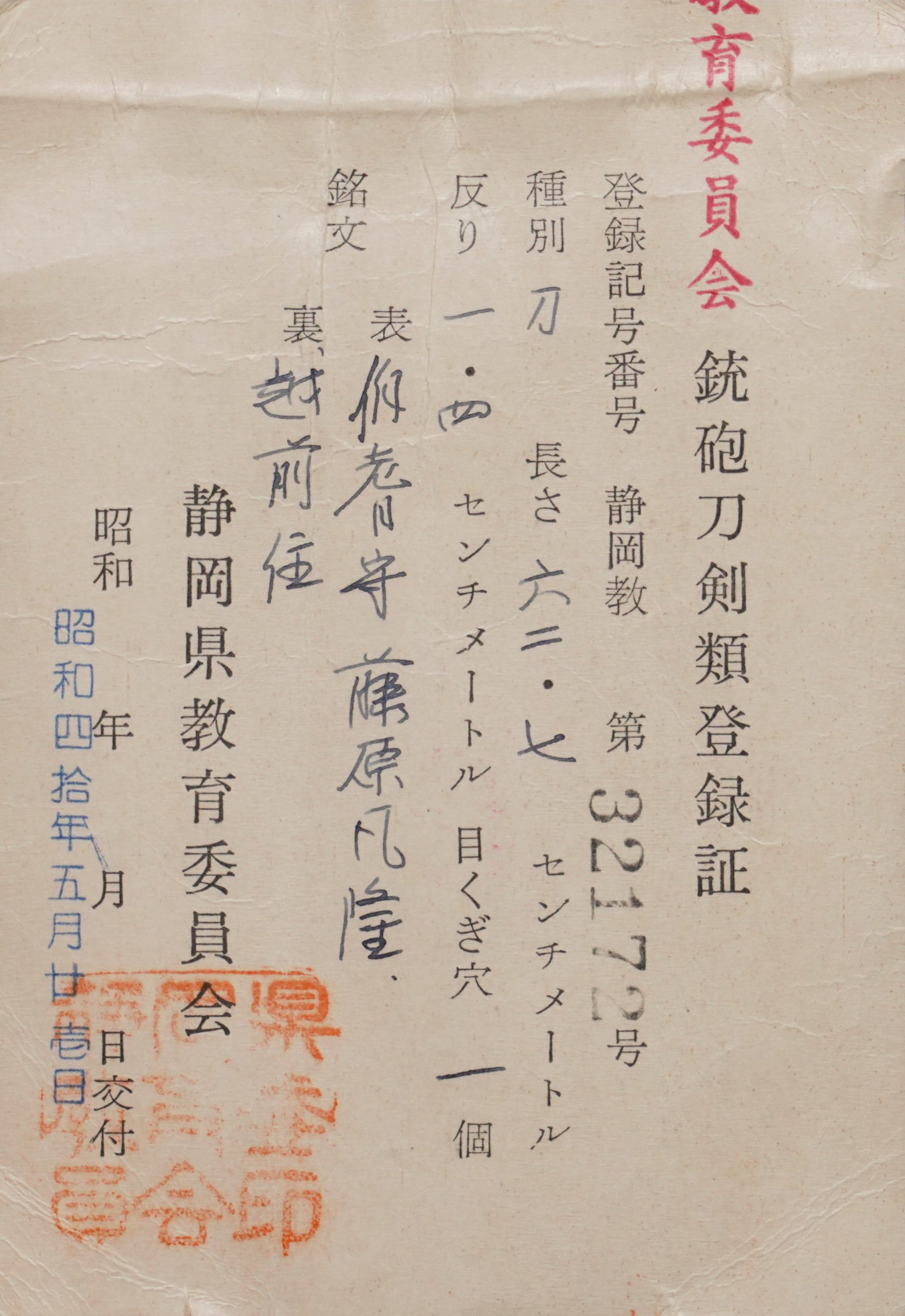
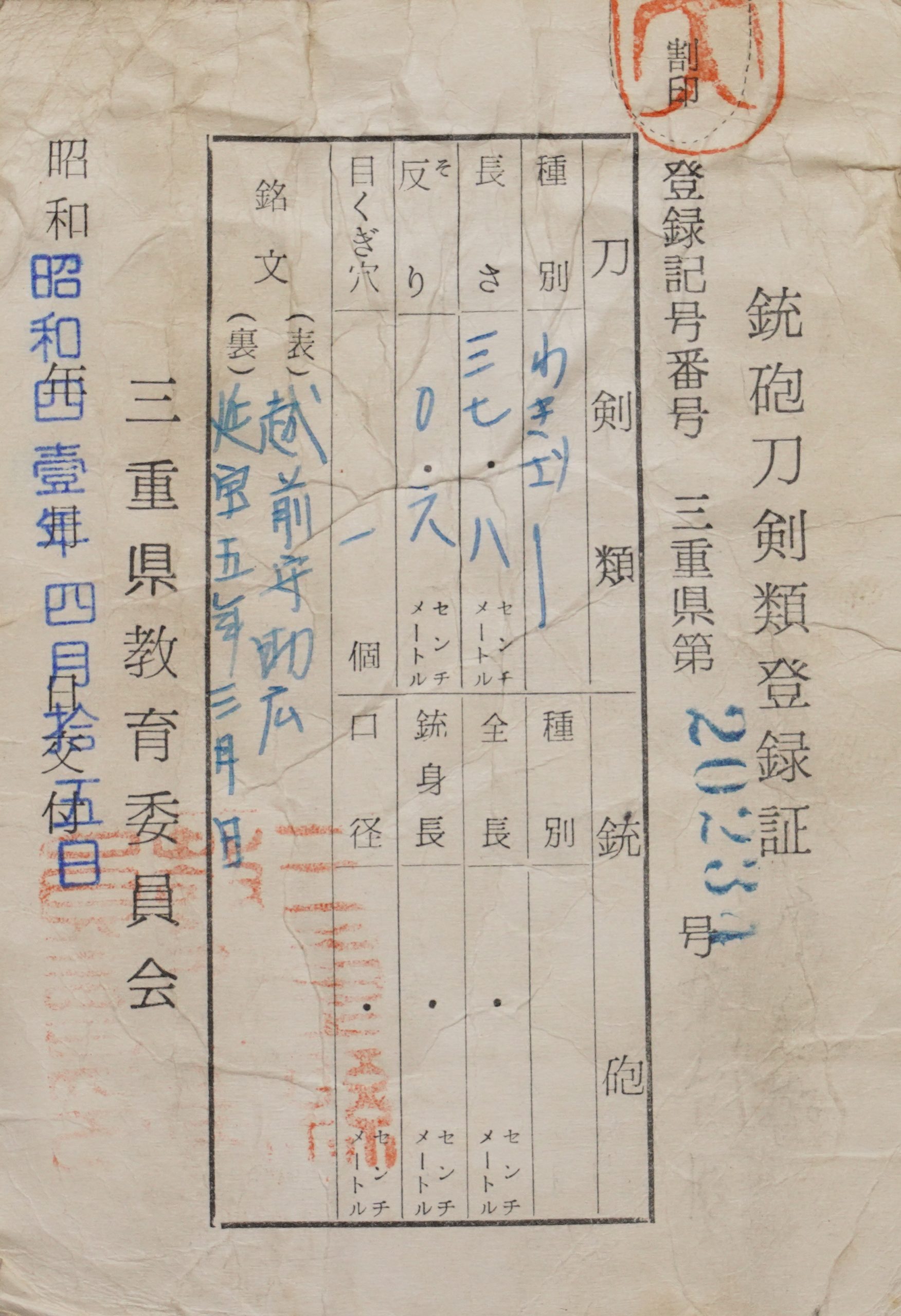

—————————————————————–
【About us】
Samurai Museum is located in Tokyo, Japan, exhibiting antique artifacts related to the Samurai history. Samurai Museum Shop is the place for those who are interested in Japanese culture and craftsmanship. We deal with antique Samurai swords/armor, traditional crafts made in Japan and so on.
【Japanese Sword& Export Process】
The Japanese swords we deal with are hand-forged edged swords made in Japan. It was made from the traditional carbon steel called TAMAHAGANE(玉鋼). Samurai Museum is familiar with the proper legal procedure for an antique/ authentic Japanese sword to be exported from Japan. We have sent more than 350 Japanese swords to amazing owners who appreciate its historical value.
Each Japanese sword is registered under the Agency for Cultural Affairs and the Board of Education in Japan.They issue a registration paper for each Japanese sword for its owner in Japan to legally possess it. The Japanese sword with its registration paper means it was traditionally hand-forged in Japan.
To legally export the sword from Japan to other countries, we will have to apply for its permit to the Agency for Cultural Affairs(Bunkacho) and return the original registration paper to the Board of Education. It normally takes around 2-4 weeks to receive this permit after submitting required documents. And we would like you to expect at least 1-1.5 months for your order to arrive at your given address after you ordered. For more detailed info, please click here.
It is allowed for residents in Japan to own authentic Japanese swords without a special license as long as they come with registration papers. Please feel free to contact us if you are a resident of Japan, whether temporarily or permanently. We will also assist you when you leave Japan and need to obtain the export permit.
【Payment Method】
We accept payment through Stripe (Credit card), PayPal, Apple Pay or ChromePay, all of which are secure payment methods. Also, you don’t need to make an account on Stripe for the checkout. If you prefer other payment method, please contact us. After confirming your payment, we will apply for an export permit. You may either pay in JPY, USD, AUD, CAD,EUR or GBP. The price is set in Japanese Yen. Prices in other currencies are automatically calculated based on the latest exchange rate.

* If the amount is above 1 million JPY, Stripe or wire transfer will be the only options for payment.
【Shipping】
We have shipped authentic Japanese swords to the USA, Canada, Mexico, UK, Germany, Switzerland, France, Hong Kong and Australia. If you don’t live in these countries and like to order, please contact us first before making a purchase. We offer Free International Shipping as long as we can send antique Japanese swords by either EMS or FedEx(Canada).
We normally ship by EMS(Express Mail Service) provided by Japan Post. When we receive an order from the Canada we will use FedEx instead as EMS temporarily stops shipping from Japan to those countries due to COVID-19.
We will send you a tracking number for your order as soon as we hand it to the post office/FedEx. We will put 100 % insurance on the shipping document without any extra charge. Based on the total amount, there might be a duty tax or other fee for you to pay, depending on the countries. We use package cushioning to protect the item and put it in a PVC pipe, which is one of the most secure packages because of its durability.
It will normally takes 5-14 days for the item to arrive at your given address after we dispatch it. Time of delivery is estimated as accurately as possible by the carrier but does not take into account any delays beyond our control such as by inclement weather, post office holiday seasons.
* If you live in Australia and like to purchase an authentic Japanese sword, please click here to know the detail.
*Please keep in mind that due to the spread of COVID-19, there might be delays in shipping. If you like to know the detail about shipping, please feel free to ask us.

【How to make sure the condition】
Please keep in mind that what you are going to purchase is an antique item. We uploaded high resolution photos for you to check its condition thoroughly. If you like to see more photos with different angles, please feel free to contact us. We will be happy to send them to you so that you can make informed decision. It is essential for us to know that you are happy with your choice of a sword. and we are prepared to use the best of our ability to serve you.
【How To Contact Us】
Please contact us through email, Facebook Messenger or Live Chat if you have any questions. You can find each icon on the right side of the website. Please click one of them to reach us. We will reply to you within 1-2 business days.
【The Art of Nihonto(Japanese Sword)】
Samurai’s history is a profound, eloquent legacy of ancient Japanese warriors in which millions of people worldwide are being fascinated. If you like to find out the art of Nihonto, please click here.
【A Guide to Japanese Sword Maintenance】
After acquiring an genuine Japanese sword, it is also important to know how to take good care of it. Here is the special video for you. Mr. Paul Martin, Japanese sword expert, shows you how to give proper maintenance to your sword. By mastering how to clean the Japanese sword, its aesthetic beauty will last forever.
When you purchase a Japanese sword from us, you can get a Free Japanese sword maintenance kit. It comes with four tools(Choji Oil, Uchiko Powder, Peg remover, Oil Applicator). By watching the video instruction above , you can enjoy learning how to maintain your Japanese sword while appreciating it.


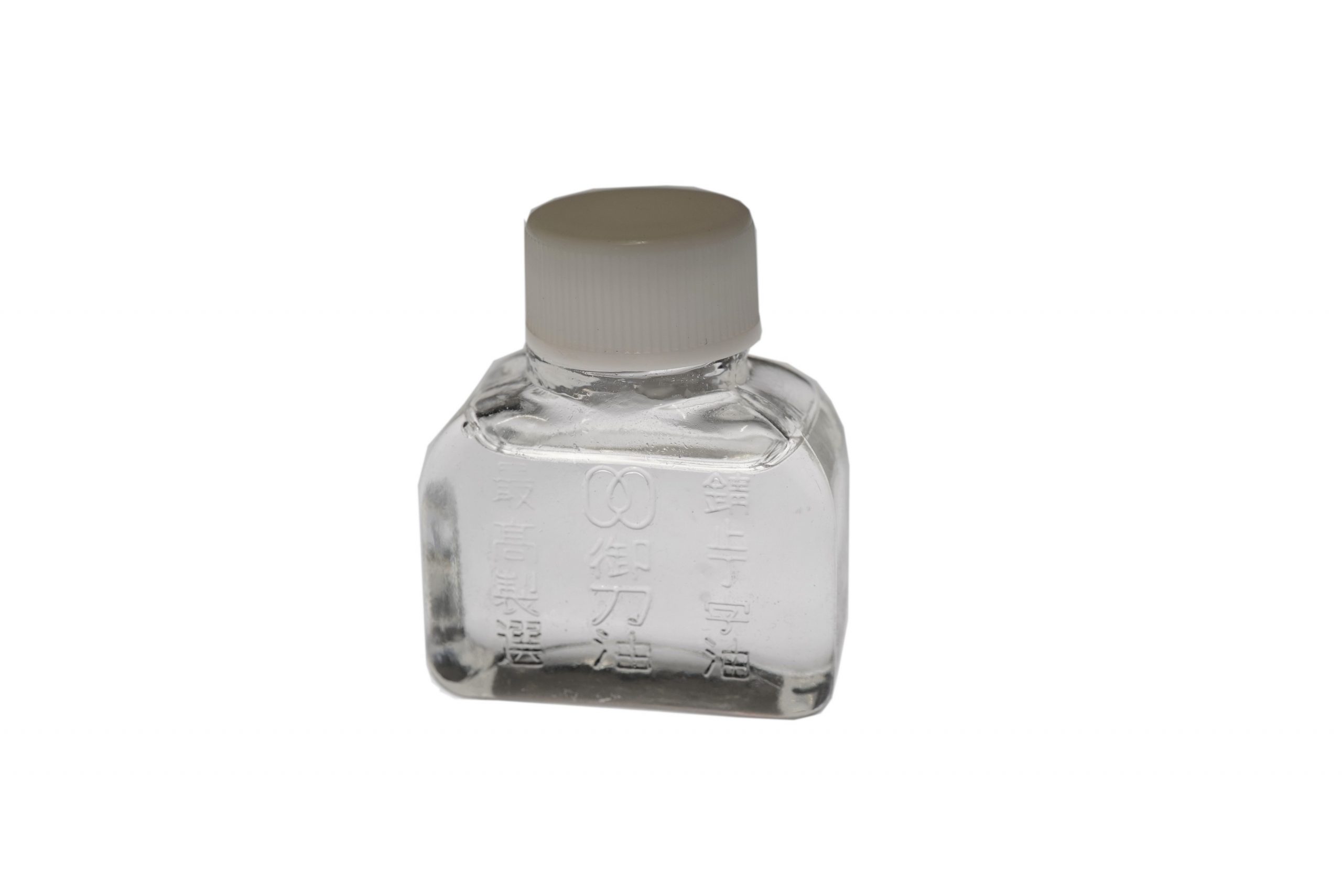
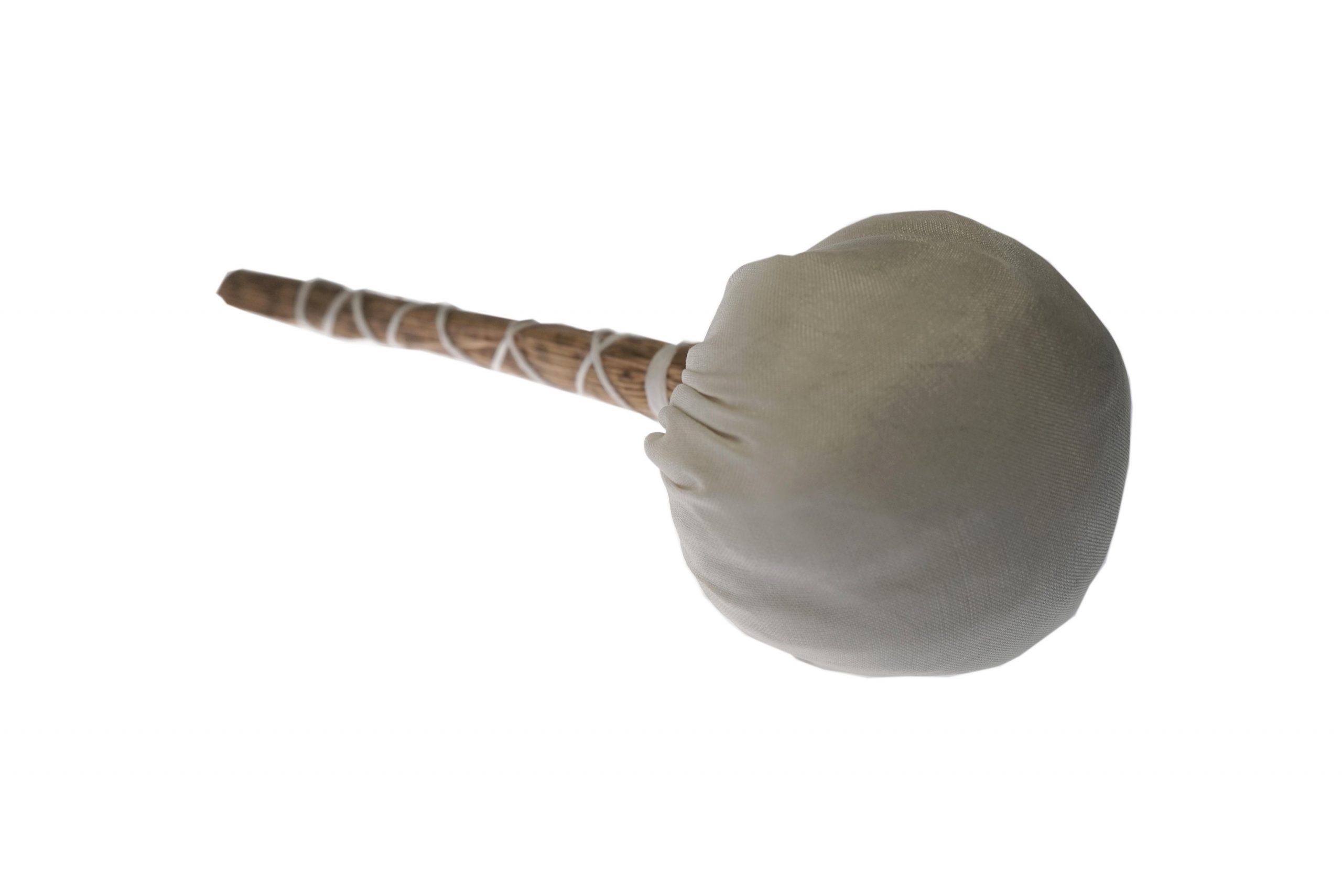
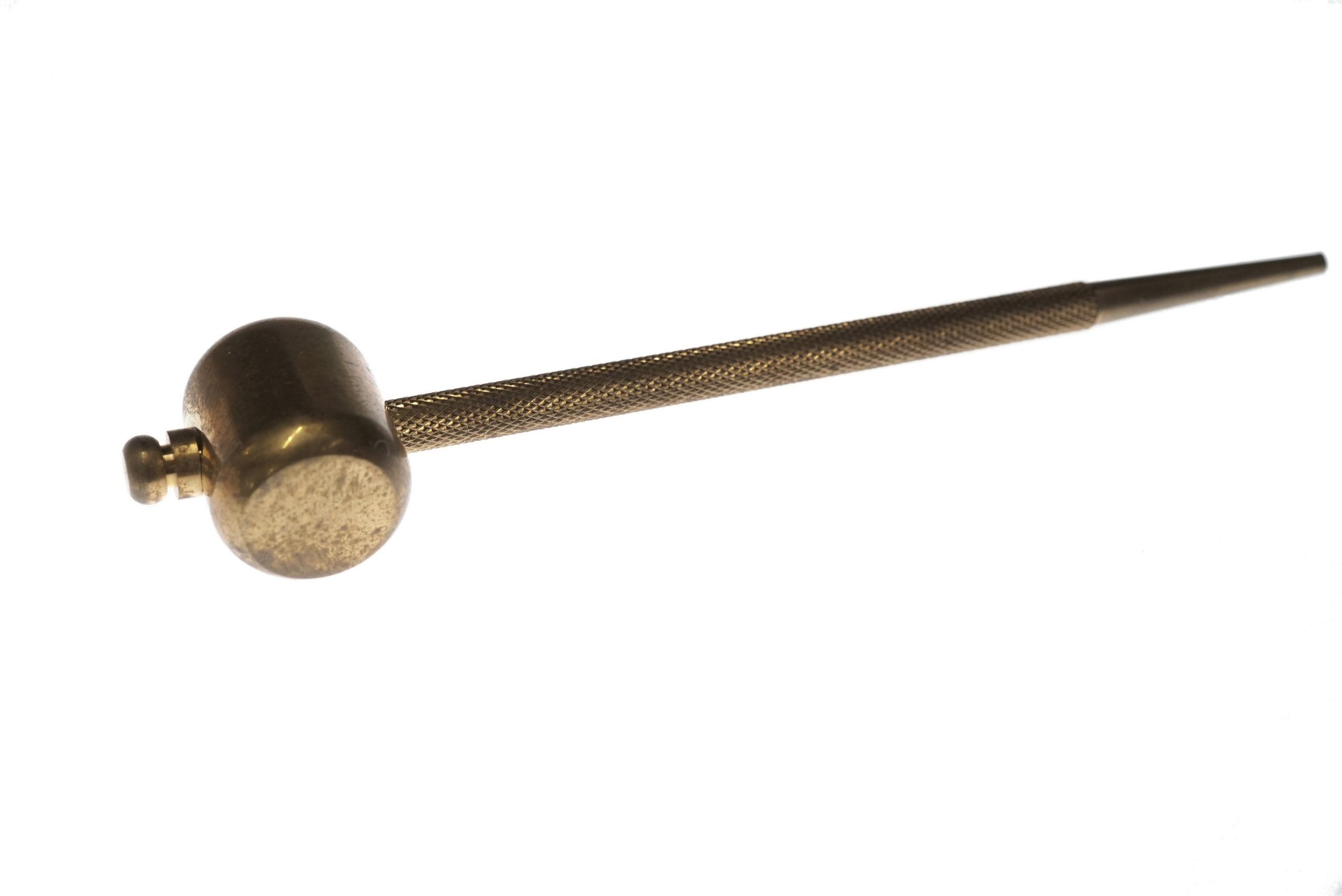
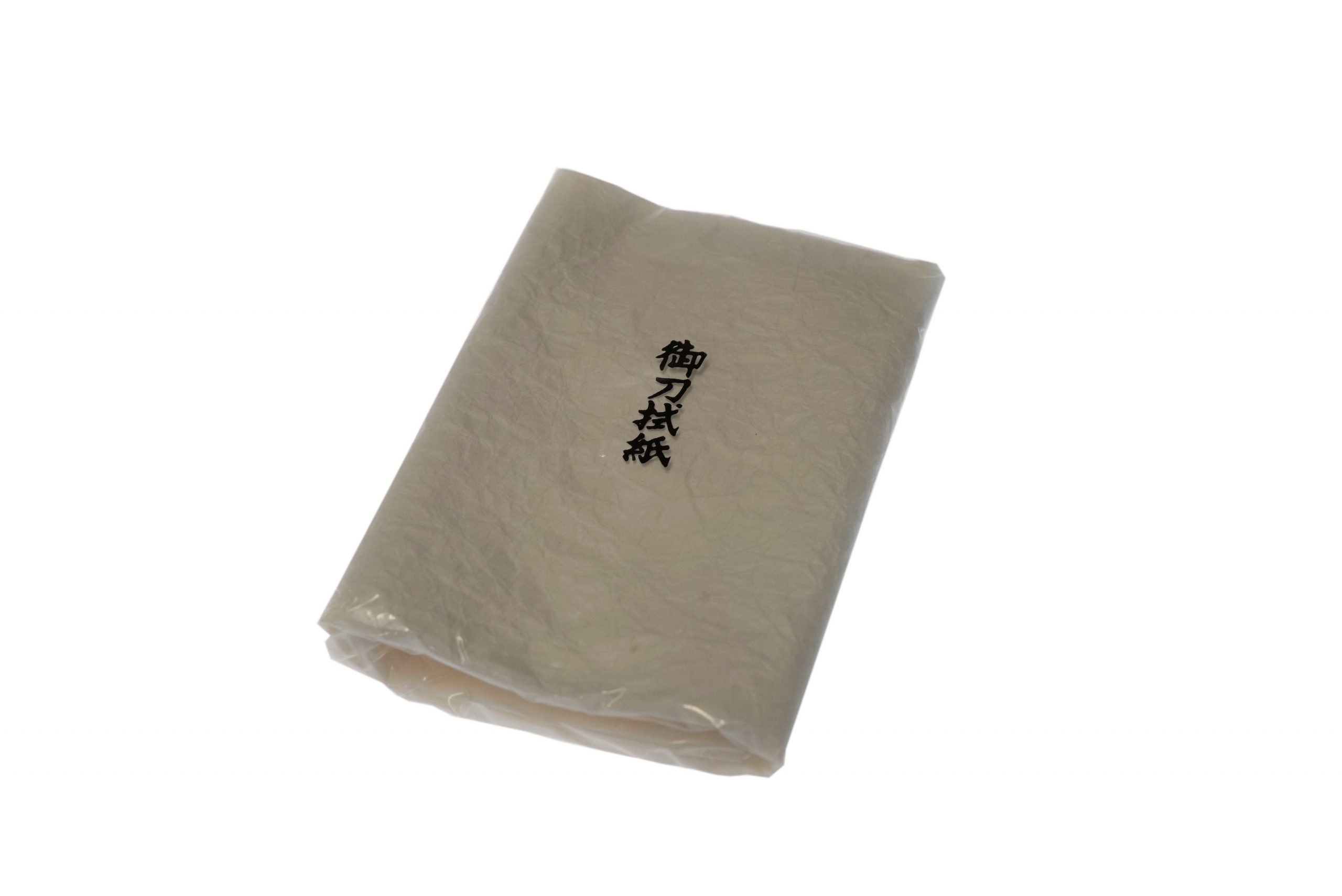
MORE ANTIQUE JAPANESE SWORD FOR SALE
LEARN JAPANESE SWORD TERMINOLOGY
Thank you for reading all the information on the page. If you have any difficulty choosing the right Japanese sword for you, we will be more than happy to help you find the one that speaks to you the most. Please feel free to contact us.
